1 Management report
1.1 Purpose of the ECB’s management report
The management report[1] is an integral part of the ECB’s Annual Accounts and is designed to provide readers with contextual information related to the financial statements.[2] Given that the ECB’s activities and operations are undertaken in support of its policy objectives, the ECB’s financial position and result should be viewed in conjunction with its policy actions.
To this end, the management report presents the ECB’s key activities and operations, as well as their impact on its financial statements. Furthermore, it analyses the main developments in the Balance Sheet and the Profit and Loss Account during the year and includes information on the ECB’s financial resources. Finally, it describes the risk environment in which the ECB operates, providing information on the financial and operational risks to which the ECB is exposed, and the risk management policies used to mitigate risks.
1.2 Activities
The ECB is part of the Eurosystem, which has the primary objective of maintaining price stability. The ECB’s main tasks, as described in the Statute of the ESCB,[3] comprise the implementation of the monetary policy of the euro area, the conduct of foreign exchange operations, the management of the official foreign reserves of the euro area countries and the promotion of the smooth operation of payment systems.
The ECB is also responsible for the effective and consistent functioning of the Single Supervisory Mechanism (SSM), with a view to carrying out intrusive and effective banking supervision, contributing to the safety and soundness of the banking system and the stability of the financial system.
The Eurosystem’s monetary policy operations are recorded in the financial statements of the ECB and of the euro area national central banks (NCBs), reflecting the principle of decentralised implementation of monetary policy in the Eurosystem. Table 1 below provides an overview of the main operations and functions of the ECB in pursuit of its mandate, and their impact on the ECB’s financial statements.
Table 1
The ECB’s key activities and their impact on its financial statements
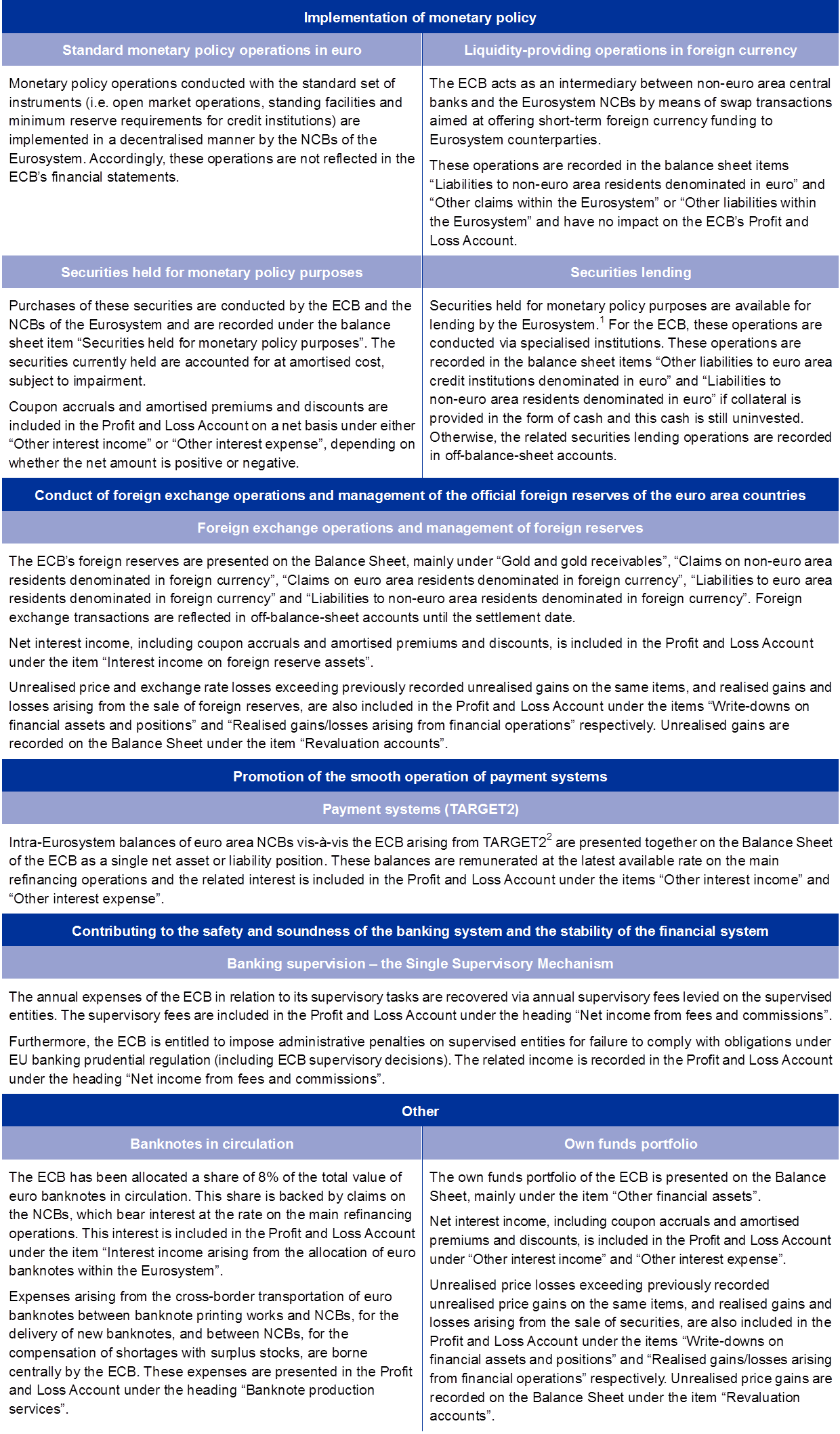
1) Further details on securities lending can be found on the ECB’s website.
2) Further details on TARGET2 can be found on the ECB’s website.
1.3 Financial developments
1.3.1 Balance Sheet
The ECB’s Balance Sheet expanded significantly in the period 2015-2018 due the acquisition of securities under the asset purchase programme (APP)[4].

In 2019 the ECB’s total assets increased by €10.0 billion to €457.1 billion. This increase was mainly due to (i) the rise in the market value of the ECB’s foreign reserve assets, owing to the increase in the price of gold and the appreciation of the US dollar and the Japanese yen vis-à-vis the euro during the year, and (ii) the rise in the value of euro banknotes in circulation.[5]
Chart 1
Main components of the ECB’s Balance Sheet
(EUR billions)

Source: ECB.

Euro-denominated securities held for monetary policy purposes constituted 55% of the ECB’s total assets as at the end of 2019. Under this balance sheet position, the ECB holds securities acquired in the context of the Securities Markets Programme (SMP), the three covered bond purchase programmes (CBPP1, CBPP2 and CBPP3), the ABSPP and the PSPP. During 2019 the ECB fully reinvested the principal payments from maturing securities held in its APP portfolios. In addition, from 1 November 2019 the ECB restarted net purchases of securities under the APP on the basis of the Governing Council’s decision of 12 September 2019 on overall monthly Eurosystem purchases[6] and subject to predetermined eligibility criteria.
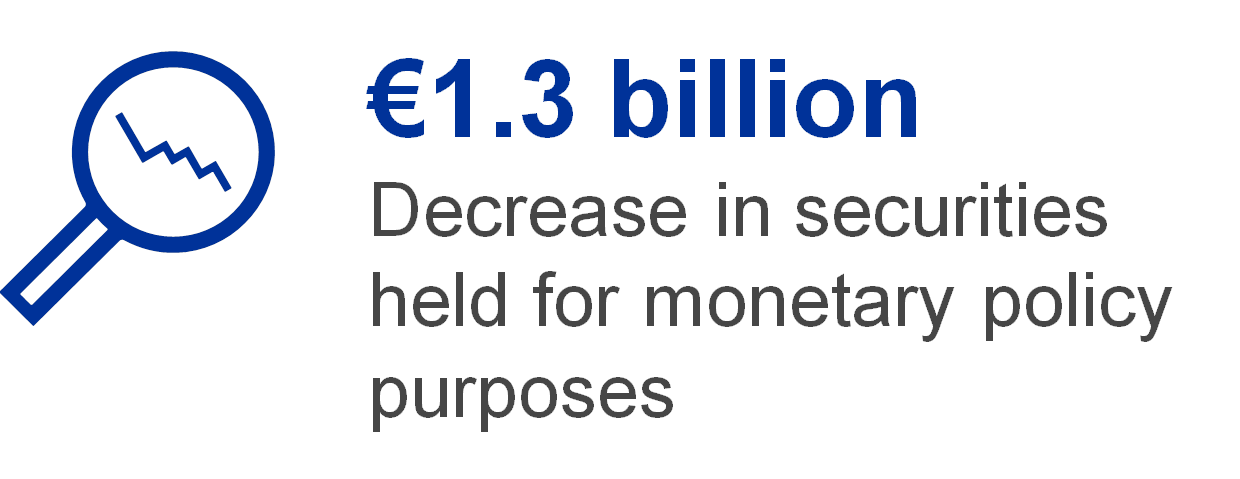
As at the end of 2019 the portfolio of securities held by the ECB for monetary policy purposes decreased by €1.3 billion to €250.4 billion (see Chart 2), mainly owing to redemptions of securities held under the SMP, CBPP1 and CBPP2. The total decrease in these holdings amounted to €2.2 billion. The €0.1 billion decrease in the PSPP portfolio was mainly due to the net impact of the amortisation of premiums and discounts[7] on securities held in the portfolio, which more than offset the net purchases conducted in the last two months of 2019.
Chart 2
Securities held for monetary policy purposes
(EUR billions)

Source: ECB.

In 2019 the total euro equivalent value of the ECB’s foreign reserve assets, which consist of gold, special drawing rights, US dollars, Japanese yen and Chinese renminbi, increased by €6.2 billion to €75.8 billion.
The euro equivalent value of the ECB’s holdings of gold and gold receivables increased by €3.8 billion to €22.0 billion in 2019 (see Chart 3), owing to an increase in the market price of gold in euro terms, while the size of these holdings in fine ounces remained unchanged. This increase also led to a rise in the ECB’s revaluation accounts, which increased by the same amount (see Section 1.3.2 “Financial resources”).
Chart 3
Gold holdings and gold prices
(left-hand scale: EUR billions; right-hand scale: euro per fine ounce of gold)

Source: ECB.
Note: “Gold revaluation accounts” does not include the contributions of the central banks of the Members States that joined the euro area after 1 January 1999 to the accumulated gold revaluation accounts of the ECB as at the day prior to their entry into the Eurosystem.
The ECB’s net foreign currency holdings[8] of US dollars, Japanese yen and Chinese renminbi increased in euro terms by €2.4 billion to €53.1 billion (see Chart 4), owing to the reinvestment of the income received during the year from these holdings and the depreciation of the euro against the US dollar and Japanese yen. The depreciation of the euro is also reflected in the higher balances in the ECB’s revaluation accounts (see Section 1.3.2 “Financial resources”).
Chart 4
Foreign currency holdings
(EUR billions)
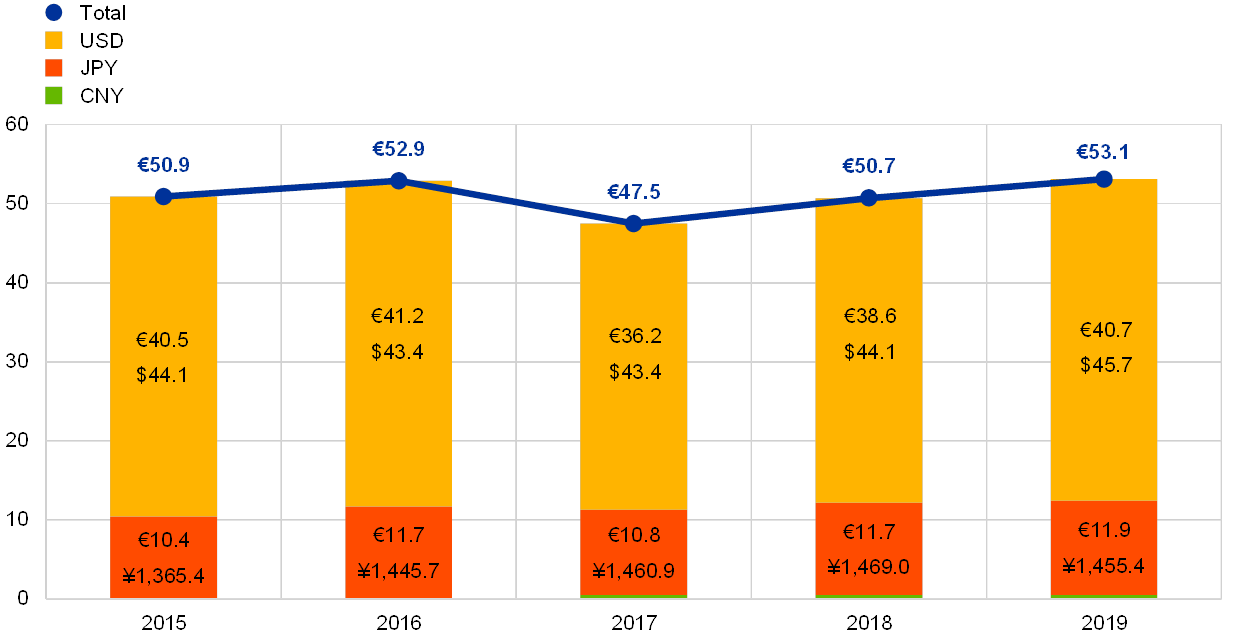
Source: ECB.
The US dollar continued to be the main component of the ECB’s foreign currency holdings, accounting for approximately 77% of the total at the end of 2019.
The ECB manages the investment of its foreign currency reserves using a three-step process. First, a strategic benchmark portfolio is designed by the ECB’s risk managers and approved by the Governing Council. Second, the ECB’s portfolio managers design the tactical benchmark portfolio, which is approved by the Executive Board. Third, day-to-day investment operations are conducted in a decentralised manner by the NCBs.
The ECB’s foreign currency reserves are mainly invested in securities and money market deposits or are held in current accounts (see Chart 5). Securities in this portfolio are valued at year-end market prices.
Chart 5
Composition of foreign currency investments
(EUR billions)
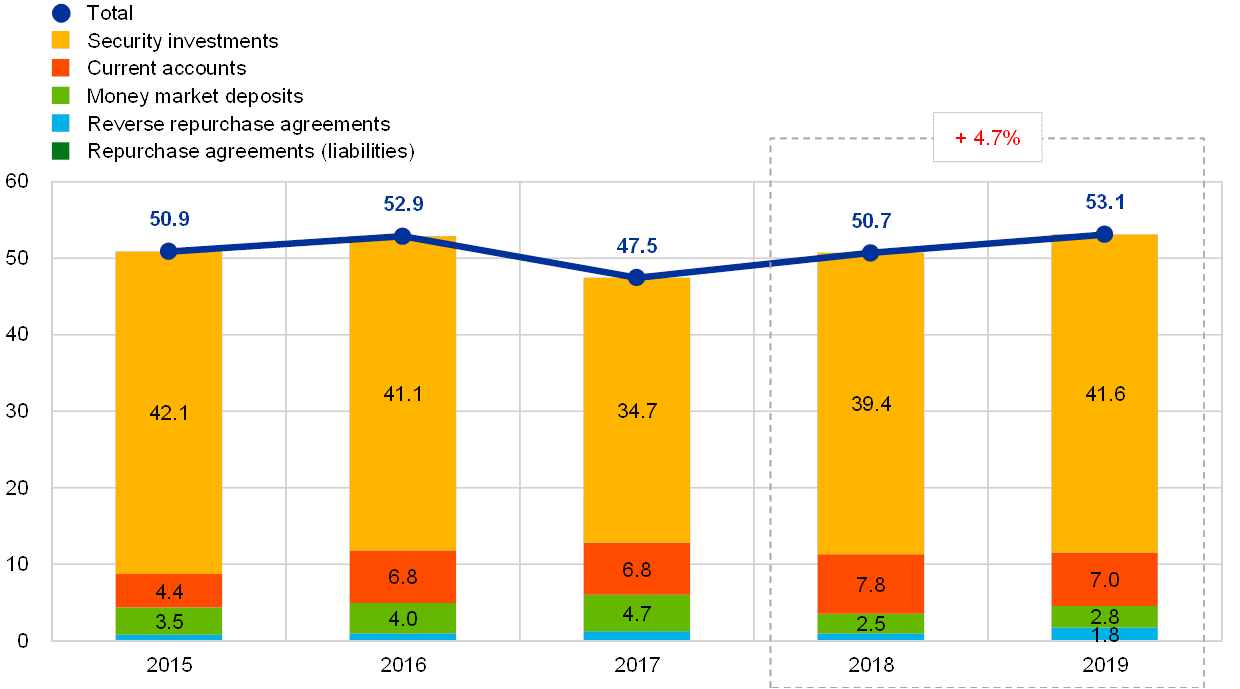
Source: ECB.
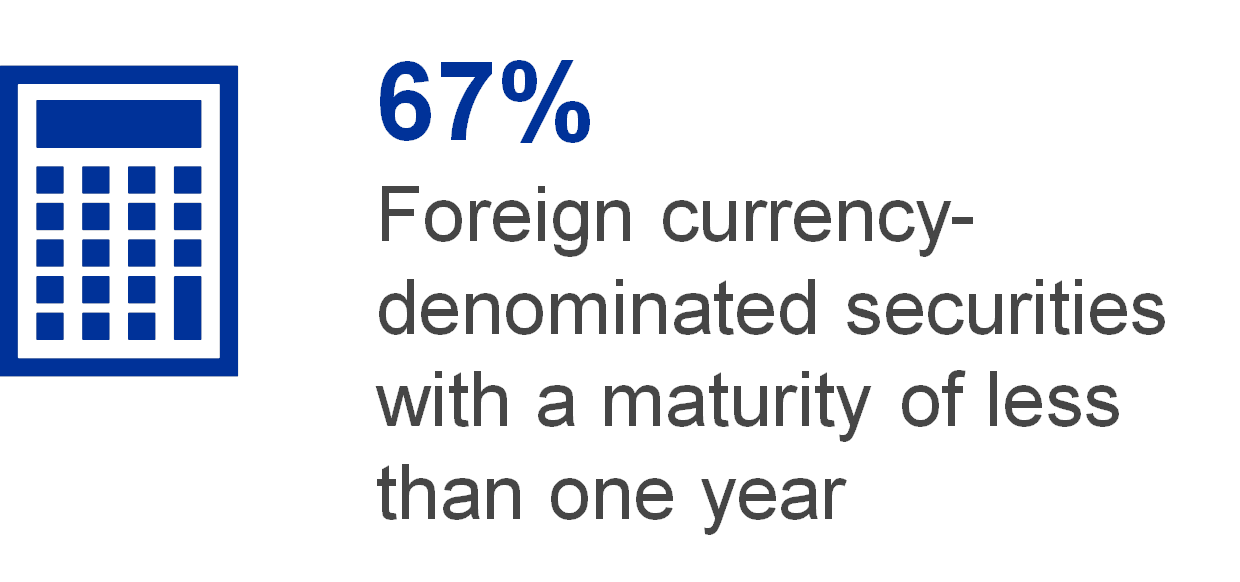
The purpose of the ECB’s foreign currency reserves is to finance potential interventions in the foreign exchange market. For this reason, the ECB’s foreign currency reserves are managed in accordance with three objectives: (in order of priority) liquidity, safety and return. Therefore, this portfolio mainly comprises securities with short maturities (see Chart 6).
Chart 6
Maturity profile of foreign currency-denominated securities
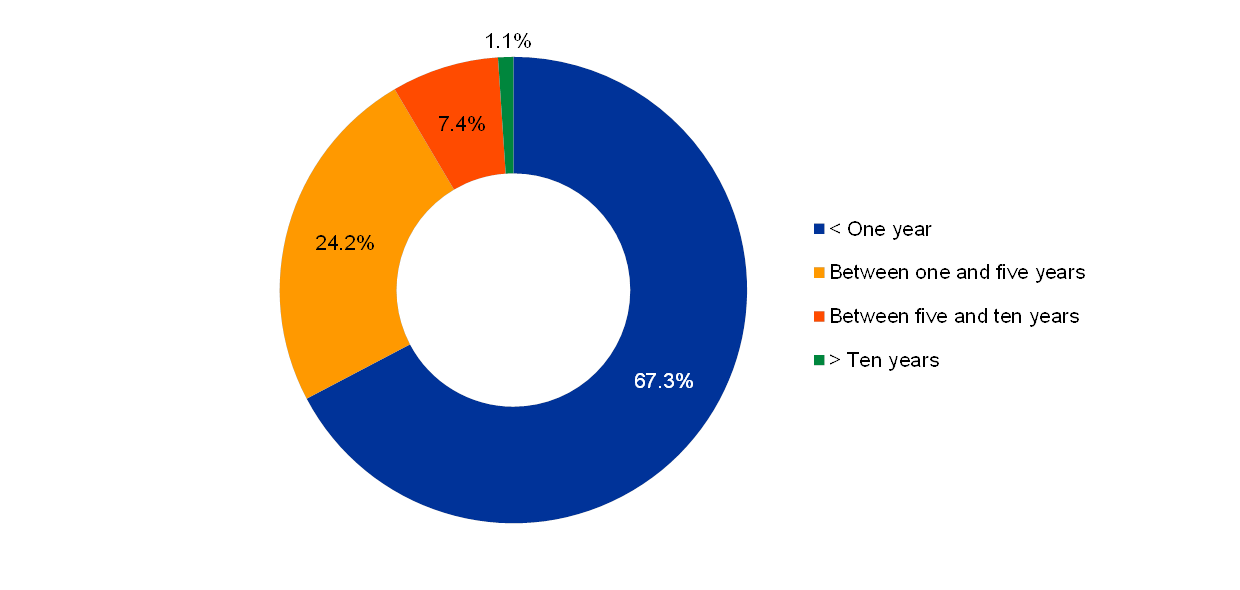
Source: ECB.
In 2019 the value of the own funds portfolio remained virtually unchanged (see Chart 7). This portfolio mainly consists of euro-denominated securities which are valued at year-end market prices.
Chart 7
The ECB’s own funds portfolio
(EUR billions)

Source: ECB.
The ECB’s own funds portfolio is held as a counterpart to its paid-up capital, the provision for financial risks and the general reserve fund. The purpose of this portfolio is to provide income to help fund the ECB’s operating expenses which are not related to the performance of its supervisory tasks.[9] In this context, the objective of the management of the own funds portfolio is to maximise returns, subject to a number of risk limits. This results in a more diversified maturity structure (see Chart 8) than in the foreign currency reserves portfolio.
Chart 8
Maturity profile of the ECB’s own funds securities
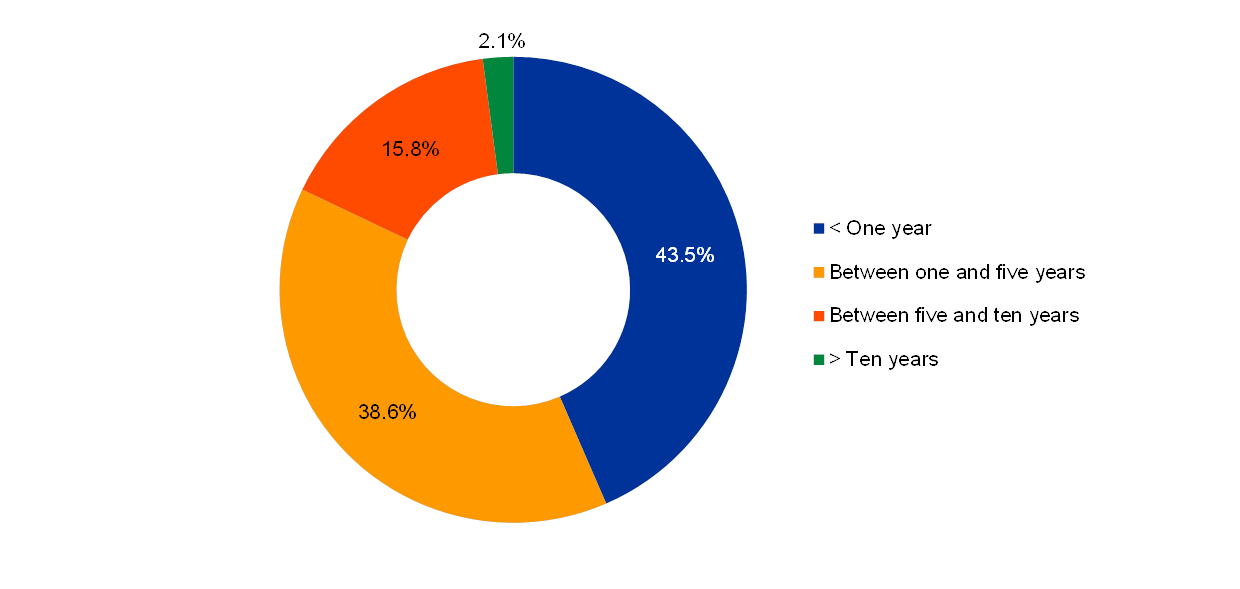
Source: ECB.
1.3.2 Financial resources

The ECB’s financial resources consist of its capital, the general risk provision, the revaluation accounts and the profit for the year. These financial resources are (i) invested in assets that generate income and/or (ii) used to directly offset losses materialising from financial risks. As at 31 December 2019, the ECB’s financial resources totalled €47.7 billion (see Chart 9). This was €5.7 billion higher than in 2018, mainly owing to an increase in the revaluation accounts following the depreciation of the euro.
Chart 9
The ECB’s financial resources
(EUR billions)

Source: ECB.
Note: “Revaluation accounts” includes total revaluation gains on gold, foreign currency and securities holdings, but excludes the revaluation account for post-employment benefits.
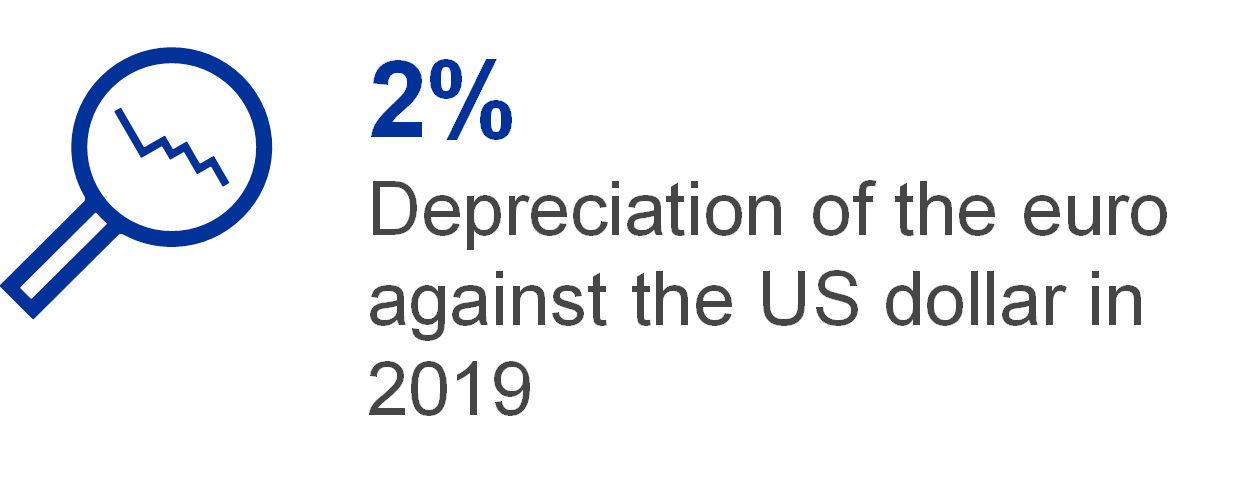
Unrealised gains on gold, foreign currencies and securities that are subject to price revaluation are not recognised as income in the Profit and Loss Account but are recorded directly in revaluation accounts shown on the liability side of the ECB’s Balance Sheet. The balances in these accounts can be used to absorb the impact of any future unfavourable movement in the respective prices and/or exchange rates, and thus strengthen the ECB’s resilience to the underlying risks. In 2019 the revaluation accounts for gold, foreign currencies and securities[10] increased by €5.1 billion to €30.2 billion, mainly owing to the increase in the price of gold and the depreciation of the euro against the US dollar and Japanese yen (see Chart 10).
Chart 10
The main foreign exchange rates and gold price over the period 2015-19
(percentage changes vis-à-vis 2015; year-end data)
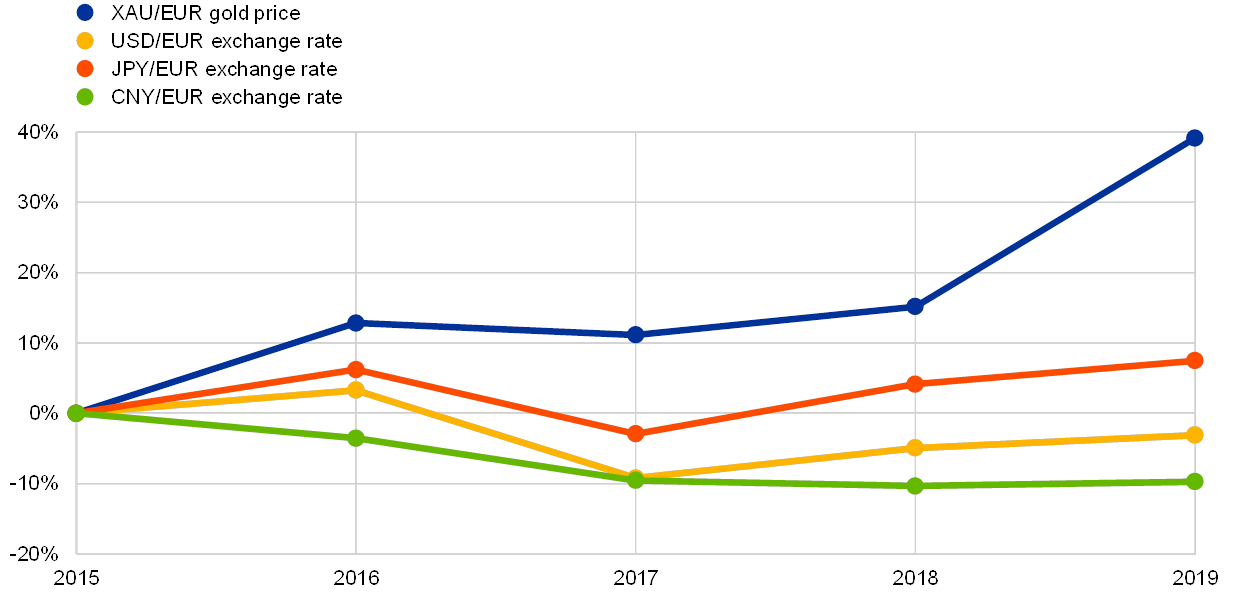
Source: ECB.
The profit resulting from the ECB’s assets and liabilities in a given financial year can be used to absorb potential losses incurred in the same year. In 2019 the ECB’s profit was €2.4 billion, €0.8 billion higher than in 2018.

In view of its exposure to financial risks (see Section 1.4.1 “Financial risks”), the ECB maintains a provision for financial risks. The size of this provision is reviewed annually, taking a range of factors into account, including the level of holdings of risk-bearing assets, the projected results for the coming year and a risk assessment. The risk provision, together with any amount held in the ECB’s general reserve fund, may not exceed the value of the capital paid up by the euro area NCBs. Following the five-yearly adjustment of the key for subscription to the ECB’s capital as at 1 January 2019 and the resulting reduction in the weightings of the euro area NCBs in the subscribed capital of the ECB, and taking into account the results of the assessment of the ECB’s exposures to financial risks, the Governing Council decided to release €84 million from the ECB’s provision for financial risks in order to comply with its maximum permitted level of €7.5 billion, which is equal to the value of the capital paid up by the euro area NCBs.
The ECB’s capital paid up by euro area and non-euro area NCBs stood at €7.7 billion on 31 December 2019, €81 million lower than at the end of 2018. This reduction was a result of the five-yearly adjustment of the ECB’s capital key that entered into force on 1 January 2019 and resulted in a decrease in the weighting of the euro area NCBs (with fully paid-up subscriptions).
In 2020 the shares of the NCBs in the capital of the ECB will change owing to the departure of the United Kingdom from the European Union and the consequent withdrawal of the Bank of England from the European System of Central Banks (ESCB). The ECB’s subscribed capital will remain unchanged, as the share of the Bank of England in the ECB’s subscribed capital will be reallocated among euro area and non-euro area NCBs. The ECB’s paid-up capital will also remain unchanged in 2020, as the remaining NCBs will cover the Bank of England’s withdrawn share of the paid-up capital.
1.3.3 Profit and Loss Account
Over the period 2015-19 the annual profit of the ECB has gradually increased from around €1.1 billion to around €2.4 billion (see Chart 11), mainly due to higher interest income generated on foreign reserve assets and on securities held for monetary policy purposes, which more than offset a decline in interest income on banknotes in circulation[11] and on the own funds portfolio.

In 2019 the ECB’s profit was €2,366 million (2018: €1,575 million). The increase of €790 million compared with 2018 was due to both an increase in net interest income and better results from financial operations.
Chart 11
Main components of the ECB’s Profit and Loss Account
(EUR millions)
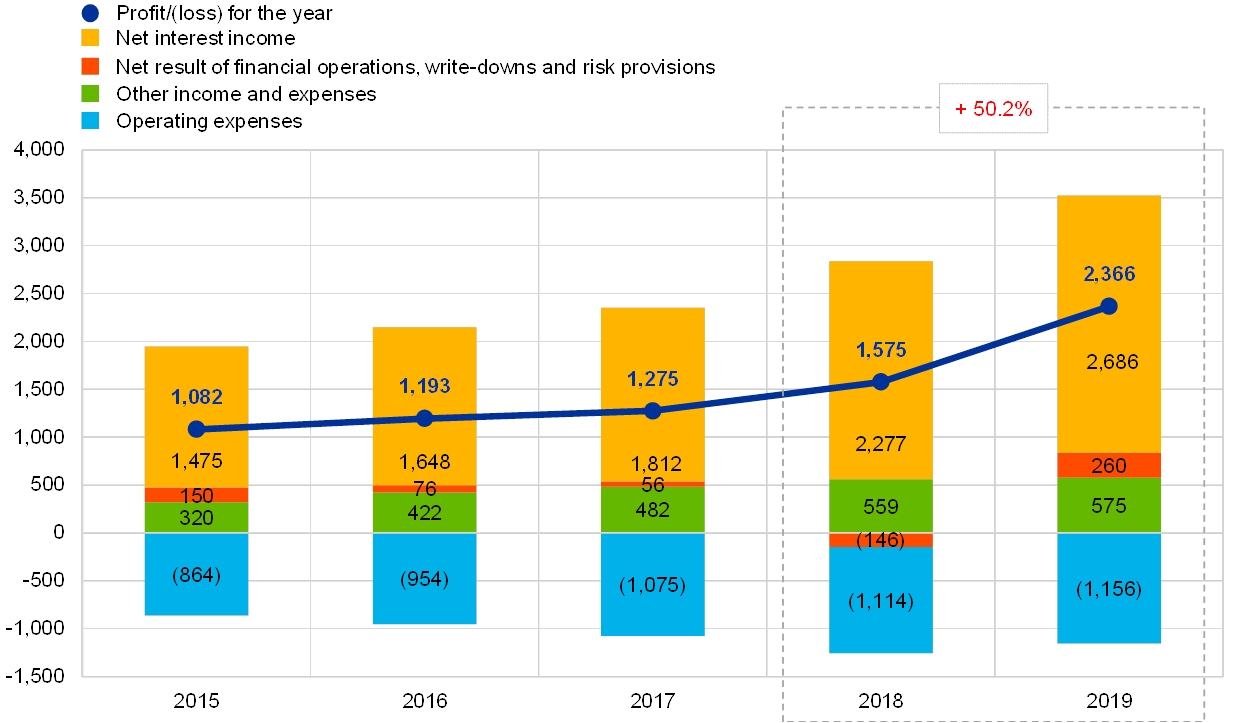
Source: ECB.
Note: “Other income and expenses” consists of “Net income/expense from fees and commissions”, “Income from equity shares and participating interests”, “Other income” and “Other expenses”.

The net interest income of the ECB increased by €410 million to €2,686 million (see Chart 12), mainly owing to higher interest income earned on both foreign reserve assets and securities held for monetary policy purposes.
Chart 12
Net interest income
(EUR millions)

Source: ECB.

Net interest income on foreign reserve assets increased by €190 million to €1,052 million, mainly as a result of the higher interest income earned on securities denominated in US dollars.
Due to the increasing trend in US dollar securities yields throughout most of 2018 (see Chart 13), in particular for short maturities, the ECB acquired securities with higher yields, thereby increasing the average yield of its US dollar portfolio compared to the previous year. This had a positive impact on the interest income earned on this portfolio during 2019.
Chart 13
Two-year sovereign bond yields in the United States, Japan and China
(percentages per annum; month-end data)
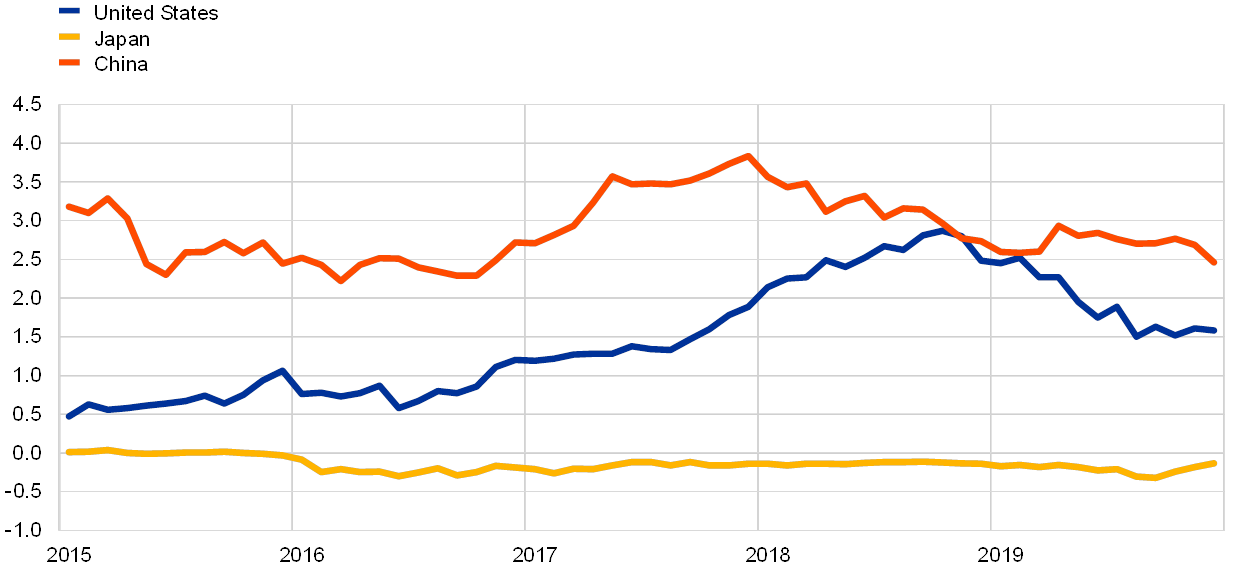
Source: ECB.

Net interest income generated on securities held for monetary policy purposes in 2019 was €1,447 million, which was €212 million higher than in 2018 (see Chart 14). Net interest income arising from APP securities increased by €316 million to €1,136 million. This increase stemmed mainly from the PSPP portfolio owing to the higher average holdings and average yield of the portfolio during the year compared to 2018. In particular, the average yield of the portfolio has increased in the last two years as a result of (i) the higher-yield securities acquired throughout 2018 compared to the historical average yield of the portfolio and (ii) the reinvestment of the principal payments in 2019 at a higher yield than that of the redeemed securities. At the same time, yields on euro area sovereign bonds remained low on average in 2019 (see Chart 15). The increased net interest income from APP securities more than offset the reduction in net interest income on the SMP, CBPP1 and CBPP2 portfolios, which fell by €104 million to €311 million, owing to the decline in the size of these portfolios as a result of the maturing of securities. In 2019 securities held for monetary policy purposes generated around 54% of the ECB’s net interest income.
Chart 14
Net interest income on securities held for monetary policy purposes
(EUR millions)

Source: ECB.
Chart 15
Ten-year sovereign bond yields in the euro area
(percentages per annum; month-end data)

Source: ECB.

Both the interest income on the ECB’s share of total euro banknotes in circulation and the interest expense related to the remuneration of NCBs’ claims in respect of foreign reserves transferred were zero as a result of the 0% interest rate used by the Eurosystem in its main refinancing operations (MROs).
Net other interest income decreased, mainly owing to lower interest income earned on the own funds portfolio as a result of the low-yield environment in the euro area.

The net result of financial operations and write-downs on financial assets amounted to a gain of €176 million (see Chart 16). This result was €322 million higher than in 2018, mainly owing to better net realised price results.
In 2019 there was a net realised price gain on sales of securities, mainly owing to price gains on US dollar-denominated securities, as their market value was positively affected by the decrease in US dollar bond yields during the year.
Chart 16
Realised results and write-downs
(EUR millions)
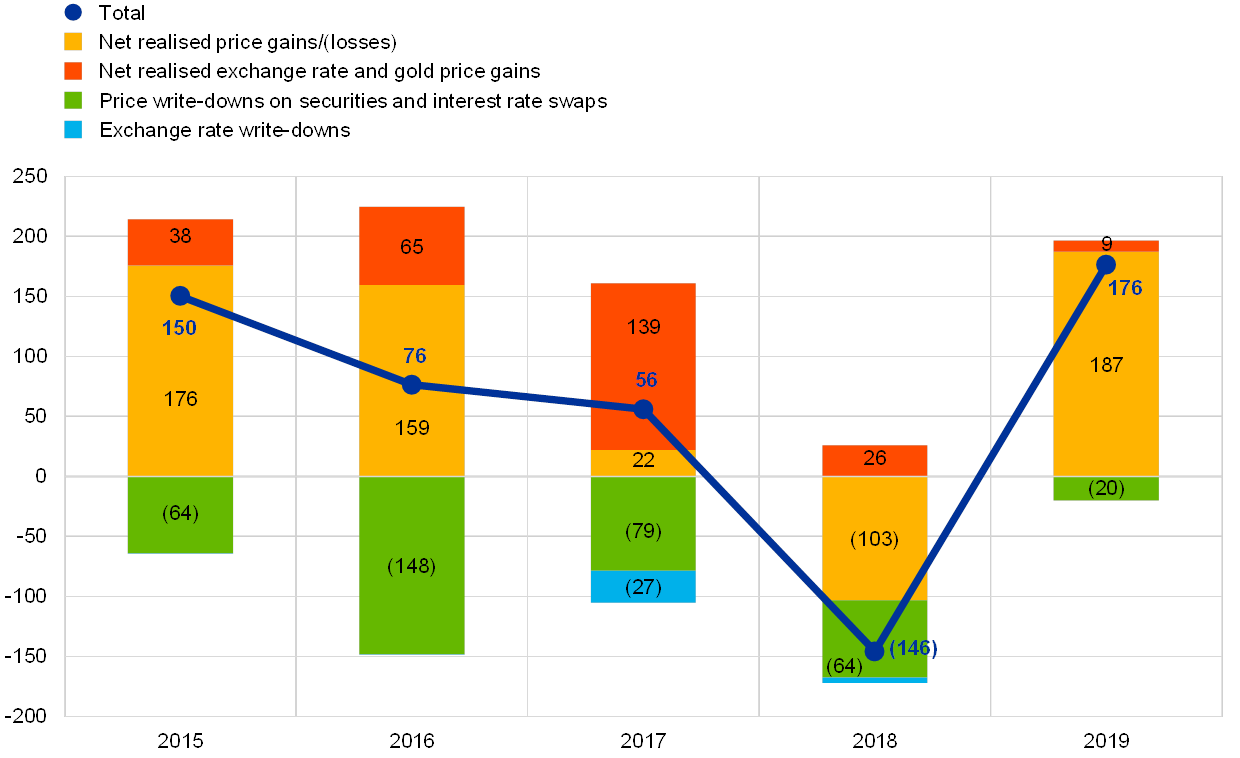
Source: ECB.
In addition, an amount of €84 million was released from the ECB’s general risk provision to the Profit and Loss Account as at 31 December 2019 in order to comply with the general risk provision upper limit as defined by the paid-up capital of the euro area NCBs (see Section 1.3.2 “Financial resources”).

The total operating expenses of the ECB, including depreciation and banknote production services, increased by €42 million to €1,156 million (see Chart 17). The increase compared to 2018 is mainly due to higher staff costs as a result of (i) the higher average number of staff in 2019, predominately in banking supervision, and (ii) the higher expense in relation to other long-term benefits, mainly owing to the lower discount rate used for the actuarial valuation at the end of 2019. Owing to the implementation of the new policy for leases in 2019, rental expenses related to leases, which were previously recognised under administrative expenses, are now recorded as depreciation. As a result, the administrative expenses were lower, while the depreciation cost was higher than the previous year. Administrative expenses also decreased due to lower costs related to agency staff and external consultancy support.
Banking supervision-related expenses are fully covered by fees levied on the supervised entities.[12]
Chart 17
Operating expenses and supervisory fees
(EUR millions)

Source: ECB.
Notes: Operating expenses are split between central banking and banking supervision. The costs of shared services provided by the ECB’s support business areas have been allocated among these two categories. These shared services are provided by the existing support business areas of the ECB, including premises, human resources management, administrative services, budgeting and controlling, accounting, legal, communication and translation services, internal audit, statistical and information technology services.
1.4 Risk management
Risk management is a critical part of the ECB’s activities and is conducted through a continuous process of (i) risk identification and assessment, (ii) review of the risk strategy and policies, (iii) implementation of risk mitigating actions, and (iv) risk monitoring and reporting, all of which are supported by effective methodologies, processes and systems.
Figure 1
Risk management cycle
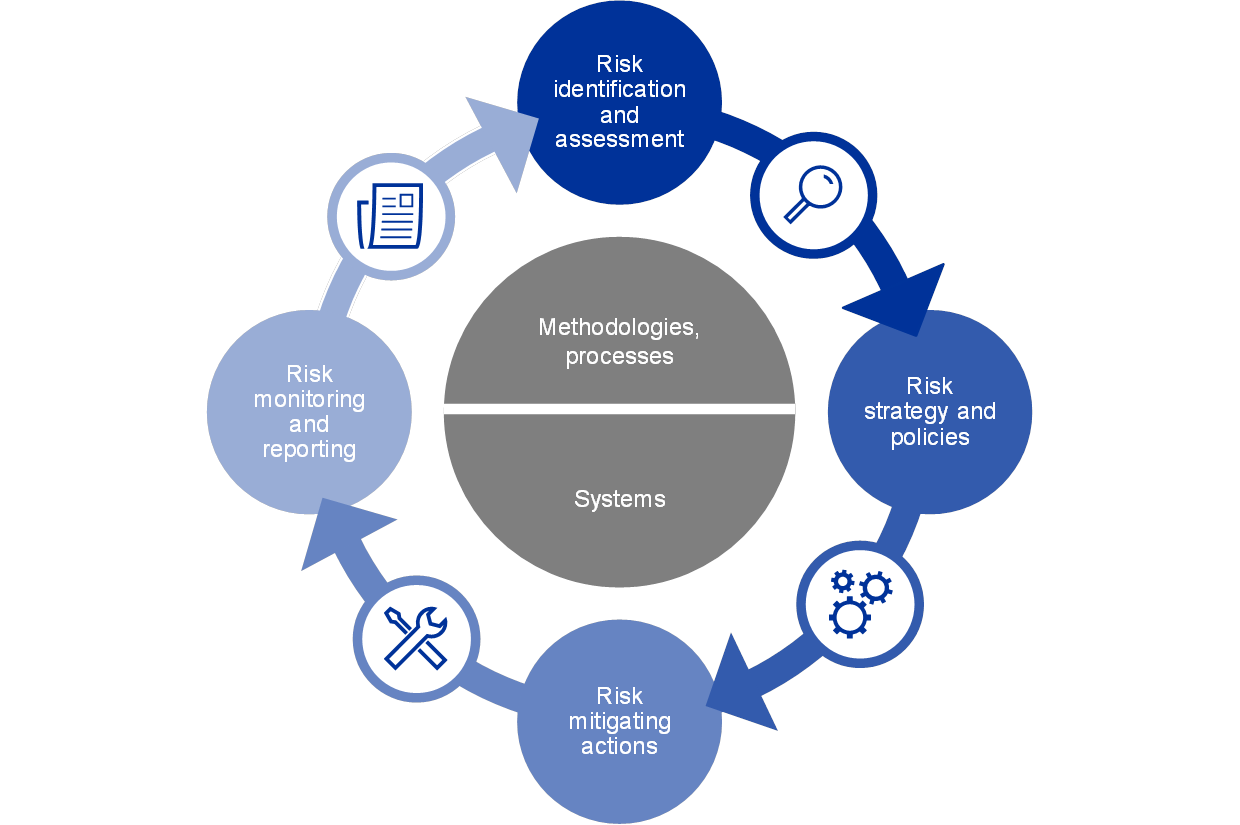
The ECB is exposed to both financial and operational risks. The following sections focus on these risks, their sources and the applicable risk control frameworks.
1.4.1 Financial risks
The Executive Board proposes policies and procedures that ensure an appropriate level of protection against the financial risks to which the ECB is exposed. The Risk Management Committee (RMC), which comprises experts from Eurosystem central banks, contributes, inter alia, to the monitoring and measuring of and reporting on financial risks related to the balance sheet of the Eurosystem, and it defines and reviews the associated methodologies and frameworks. In this way, the RMC helps the decision-making bodies to ensure an appropriate level of protection for the Eurosystem.
Financial risks arise from the ECB’s core activities and associated exposures. The risk control frameworks and limits that the ECB uses to manage its risk profile differ across types of operation, reflecting the policy or investment objectives of the different portfolios and the risk characteristics of the underlying assets.
To monitor and assess the risks, the ECB relies on a number of risk estimation techniques developed in-house. These techniques are based on a joint market and credit risk simulation framework. The core modelling concepts, techniques and assumptions underlying the risk measures draw on industry standards and available market data. The risks are typically quantified by the expected shortfall (ES),[13] estimated at the 99% confidence level over a one-year horizon. Two approaches are used to calculate risks: (i) the accounting approach, under which the ECB’s revaluation accounts are considered as a buffer in the calculation of risk estimates in line with all applicable accounting rules; and (ii) the financial approach, under which the revaluation accounts are not considered as a buffer in the risk calculation. The ECB also calculates other risk measures at different confidence levels, performs sensitivity and stress scenario analyses, and assesses longer-term projections of exposures and income to maintain a comprehensive picture of the risks.[14]

The total risks of the ECB decreased during the year. At the end of 2019 the total financial risks for all the ECB’s portfolios combined, as measured by the ES at the 99% confidence level over a one-year horizon following the accounting approach, stood at €8.1 billion, which was €1.1 billion lower than the risks estimated as at the end of 2018. The decrease reflects lower currency and interest rate risk in the ECB’s investment portfolios, improvements in the credit quality of securities held in the ECB’s portfolios and redemptions of securities held under the SMP, CBPP1 and CBPP2.

Credit risk arises from the ECB’s monetary policy portfolios, its euro-denominated own funds portfolio and its foreign reserve holdings. While securities held for monetary policy purposes are valued at amortised cost subject to impairment and are therefore, in the absence of sales, not subject to price changes associated with credit migrations, they are still subject to credit default risk. Euro-denominated own funds and foreign reserves are valued at market prices and, as such, are subject to credit migration and default risk. Credit risk decreased compared with the previous year owing to improvements in the credit quality of several European sovereigns and redemptions in the SMP holdings.
Credit risk is mitigated mainly through the application of eligibility criteria, due diligence procedures and limits that differ across portfolios.

Currency and commodity risks arise from the ECB’s foreign currency and gold holdings. The currency risk decreased compared to the previous year owing to higher revaluation accounts, which act as buffers against adverse exchange rate and gold price movements.
In view of the policy role of these assets, the ECB does not hedge the related currency and commodity risks. Instead, these risks are mitigated through the existence of revaluation accounts and the diversification of the holdings across different currencies and gold.

The ECB’s foreign reserves and euro-denominated own funds are mainly invested in fixed income securities and are subject to mark-to-market interest rate risk, given that they are valued at market prices. The ECB’s foreign reserves holdings are mainly invested in assets with relatively short maturities (see Chart 6 in Section 1.3.1 “Balance Sheet”), while the assets in the own funds portfolio generally have longer maturities (see Chart 8 in Section 1.3.1 “Balance Sheet”). This risk component, as measured under the accounting approach, decreased compared to 2018, reflecting developments in market conditions.
The mark-to-market interest rate risk of the ECB is mitigated through asset allocation policies and the revaluation accounts.
The ECB is also subject to interest rate risk arising from mismatches between the interest rate earned on its assets and the interest rate paid on its liabilities, which has an impact on its net interest income. This risk is not directly linked to any particular portfolio but rather to the structure of the ECB’s Balance Sheet as a whole and, in particular, the existence of maturity and yield mismatches between assets and liabilities. It is monitored by means of projections of the ECB’s profitability, which indicate that the ECB is expected to continue to earn net interest income in the coming years.
This type of risk is managed through asset allocation policies and is further mitigated by the existence of unremunerated liabilities on the ECB’s Balance Sheet.
1.4.2 Operational risk
The ECB’s operational risk[15] management (ORM) covers all non-financial risks.
The Executive Board is responsible for and approves the ECB’s ORM policy and framework. The Operational Risk Committee (ORC) supports the Executive Board in the performance of its role in overseeing the management of operational risks. ORM is an integral part of the ECB’s governance structure[16] and management processes.
The main objective of the ECB’s ORM framework is to contribute to ensuring that the ECB achieves its mission and objectives, while protecting its reputation and assets against loss, misuse and damage. Under the ORM framework, each business area is responsible for identifying, assessing, responding to, reporting on and monitoring its operational risks, incidents and controls. In this context, the ECB’s risk tolerance policy provides guidance with regard to risk response strategies and risk acceptance procedures. It is linked to a five-by-five risk matrix based on impact and likelihood grading scales using quantitative and qualitative criteria.
The environment in which the ECB operates is exposed to increasingly complex threats and there are a wide range of operational risks associated with the ECB’s day-to-day activities. The main areas of concern for the ECB include a wide spectrum of non-financial risks resulting from people, information, systems, processes and external third-party providers. Consequently, the ECB has put in place processes to facilitate ongoing and effective management of its operational risks and to integrate risk information into the decision-making process. Moreover, the ECB focuses on enhancing its resilience. As such, response structures and contingency plans have been established to ensure the continuity of critical business functions in the event of any disruption.
2 Financial statements of the ECB
2.1 Balance Sheet as at 31 December 2019
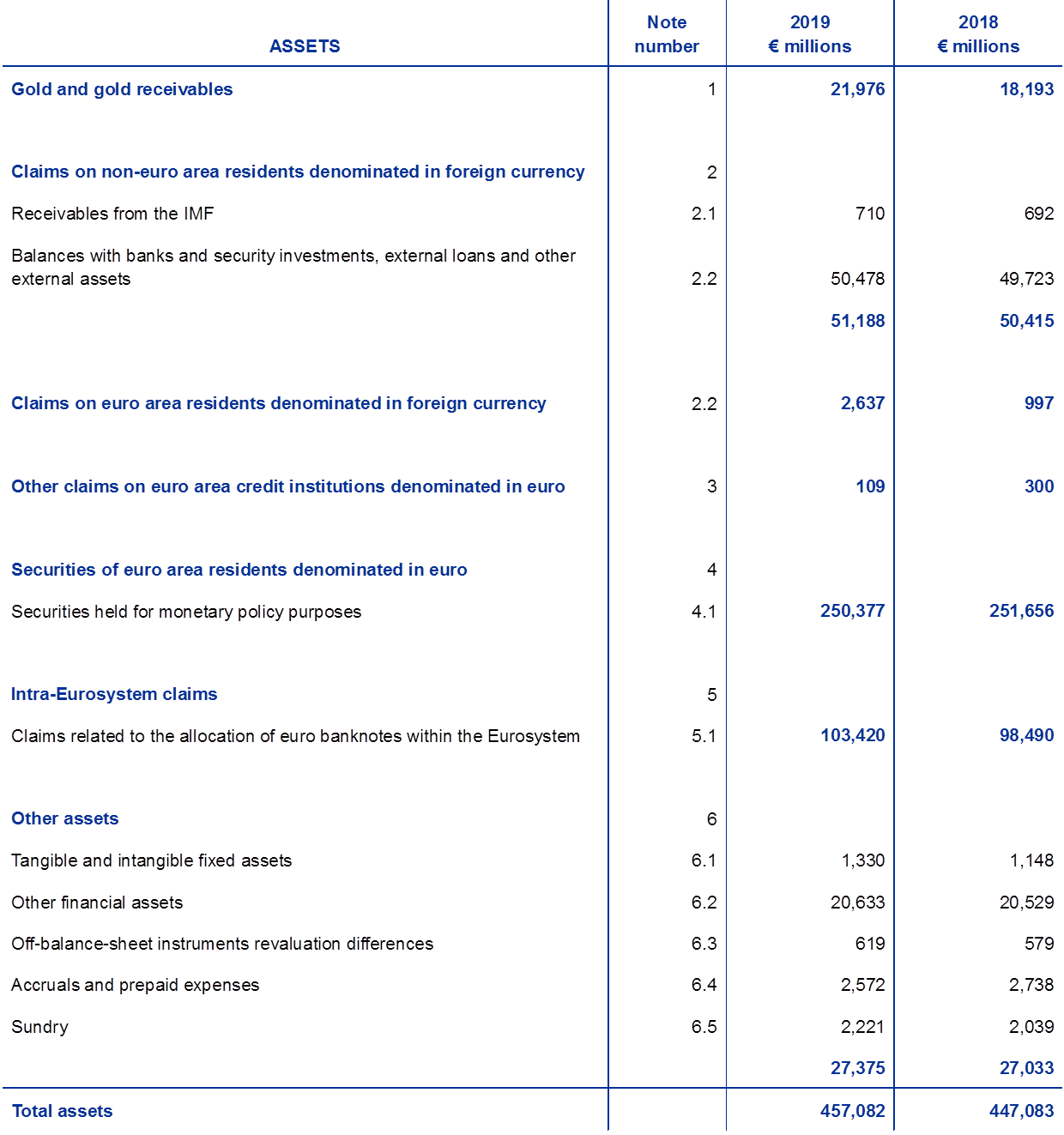
Notes: Totals in the financial statements and in the tables included in the notes may not add up due to rounding. The figures 0 and (0) indicate positive or negative amounts rounded to zero, while a dash (-) indicates zero.
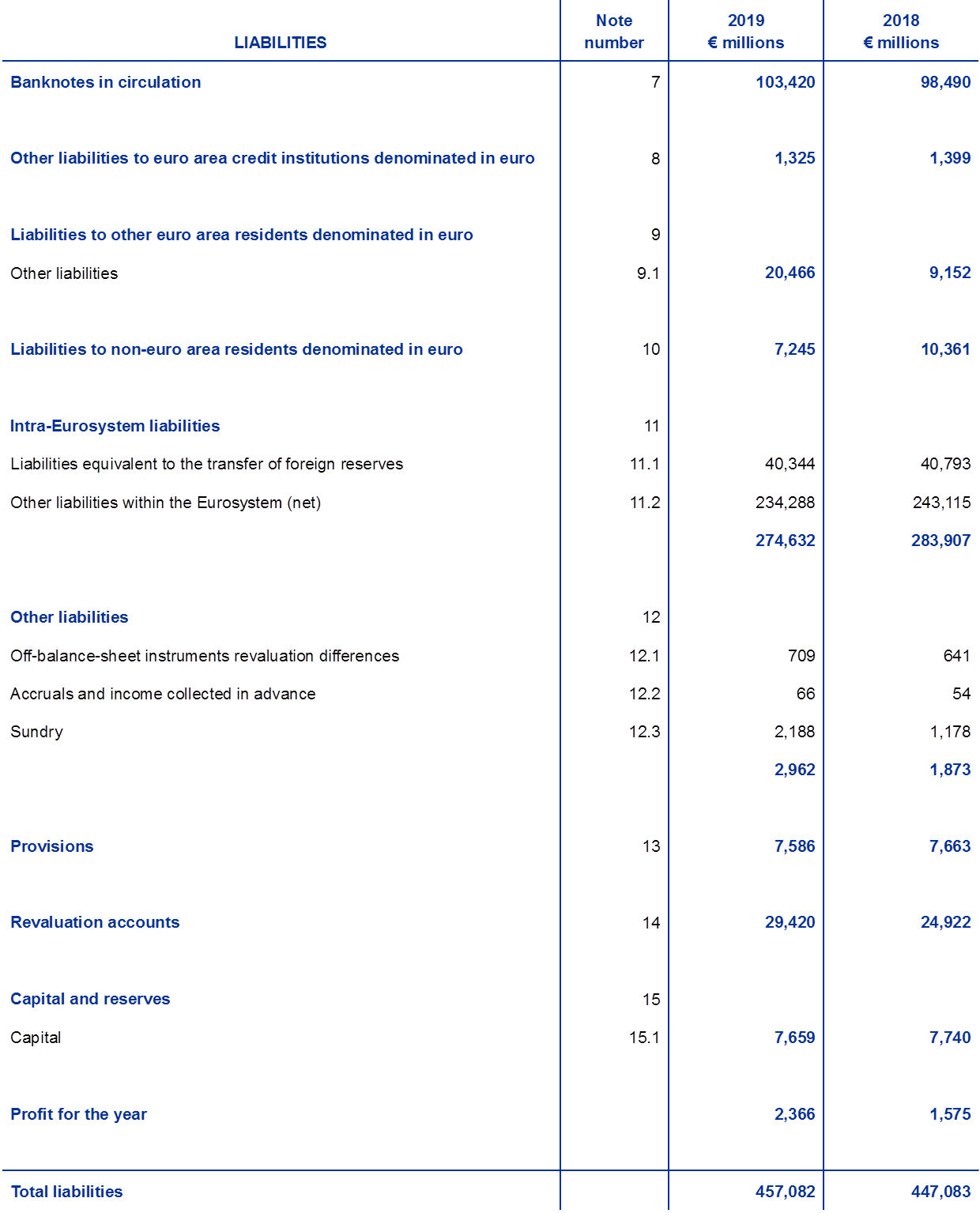
2.2 Profit and Loss Account for the year ending 31 December 2019

Frankfurt am Main, 11 February 2020
European Central Bank
Christine Lagarde
President
2.3 Accounting policies
Form and presentation of the financial statements
The financial statements of the ECB have been drawn up in accordance with the following accounting policies,[17] which the Governing Council of the ECB considers to achieve a fair presentation of the financial statements, reflecting at the same time the nature of central bank activities.
Accounting principles
The following accounting principles have been applied: economic reality and transparency, prudence, recognition of post-balance sheet events, materiality, going concern, the accruals principle, consistency and comparability.
Recognition of assets and liabilities
An asset or liability is only recognised in the Balance Sheet when it is probable that any associated future economic benefit will flow to or from the ECB, substantially all of the associated risks and rewards have been transferred to the ECB, and the cost or value of the asset or the amount of the obligation can be measured reliably.
Basis of accounting
The accounts have been prepared on a historical cost basis, modified to include the market valuation of marketable securities (other than securities currently held for monetary policy purposes), gold and all other on-balance-sheet and off-balance-sheet assets and liabilities denominated in foreign currency.
Transactions in financial assets and liabilities are reflected in the accounts on the basis of the date on which they were settled.
With the exception of spot transactions in securities, transactions in financial instruments denominated in foreign currency are recorded in off-balance-sheet accounts on the trade date. At the settlement date the off-balance-sheet entries are reversed and transactions are booked on-balance-sheet. Purchases and sales of foreign currency affect the net foreign currency position on the trade date, and realised results arising from sales are also calculated on that date. Accrued interest, premiums and discounts related to financial instruments denominated in foreign currency are calculated and recorded daily, and the foreign currency position is also affected daily by these accruals.
Gold and foreign currency assets and liabilities
Assets and liabilities denominated in foreign currency are converted into euro at the exchange rate prevailing on the balance sheet date. Income and expenses are converted at the exchange rate prevailing on the recording date. The revaluation of foreign exchange assets and liabilities, including on-balance-sheet and off-balance-sheet instruments, is performed on a currency-by-currency basis.
Revaluation to the market price for assets and liabilities denominated in foreign currency is treated separately from the exchange rate revaluation.
Gold is valued at the market price prevailing at the balance sheet date. No distinction is made between the price and currency revaluation differences for gold. Instead, a single gold valuation is accounted for on the basis of the price in euro per fine ounce of gold, which, for the year ending 31 December 2019, was derived from the exchange rate of the euro against the US dollar on 31 December 2019.
The special drawing right (SDR) is defined in terms of a basket of currencies and its value is determined by the weighted sum of the exchange rates of five major currencies (the US dollar, euro, Chinese renminbi, Japanese yen and pound sterling). The ECB’s holdings of SDRs were converted into euro using the exchange rate of euro per SDR as at 31 December 2019.
Securities
Securities held for monetary policy purposes
Securities currently held for monetary policy purposes are accounted for at amortised cost subject to impairment.
Other securities
Marketable securities (other than securities currently held for monetary policy purposes) and similar assets are valued either at the mid-market prices or on the basis of the relevant yield curve prevailing on the balance sheet date, on a security-by-security basis. Options embedded in securities are not separated for valuation purposes. For the year ending 31 December 2019, mid-market prices on 30 December 2019 were used. Illiquid equity shares and any other equity instruments held as permanent investments are valued at cost subject to impairment.
Income recognition
Income and expenses are recognised in the period in which they are earned or incurred.[18] Realised gains and losses arising from the sale of foreign currency, gold and securities are taken to the Profit and Loss Account. Such realised gains and losses are calculated by reference to the average cost of the respective asset.
Unrealised gains are not recognised as income and are transferred directly to a revaluation account.
Unrealised losses are taken to the Profit and Loss Account if, at the year-end, they exceed previous revaluation gains registered in the corresponding revaluation account. Such unrealised losses on any one security or currency or on gold are not netted against unrealised gains on other securities or currencies or gold. In the event of such unrealised losses on any item taken to the Profit and Loss Account, the average cost of that item is reduced to the year-end exchange rate or market price. Unrealised losses on interest rate swaps that are taken to the Profit and Loss Account at the year-end are amortised in subsequent years.
Impairment losses are taken to the Profit and Loss Account and are not reversed in subsequent years unless the impairment decreases and the decrease can be related to an observable event that occurred after the impairment was first recorded.
Premiums or discounts arising on securities are amortised over the securities’ remaining contractual life.
Reverse transactions
Reverse transactions are operations whereby the ECB buys or sells assets under a repurchase agreement or conducts credit operations against collateral.
Under a repurchase agreement, securities are sold for cash with a simultaneous agreement to repurchase them from the counterparty at an agreed price on a set future date. Repurchase agreements are recorded as collateralised deposits on the liability side of the Balance Sheet. Securities sold under such an agreement remain on the Balance Sheet of the ECB.
Under a reverse repurchase agreement, securities are bought for cash with a simultaneous agreement to sell them back to the counterparty at an agreed price on a set future date. Reverse repurchase agreements are recorded as collateralised loans on the asset side of the Balance Sheet, but are not included in the ECB’s security holdings.
Reverse transactions (including securities lending transactions) conducted under a programme offered by a specialised institution are recorded on the Balance Sheet only where collateral has been provided in the form of cash and this cash remains uninvested.
Off-balance-sheet instruments
Currency instruments, namely foreign exchange forward transactions, forward legs of foreign exchange swaps and other currency instruments involving an exchange of one currency for another at a future date, are included in the net foreign currency position for the purpose of calculating foreign exchange gains and losses.
Interest rate instruments are revalued on an item-by-item basis. Daily changes in the variation margin of open interest rate futures contracts, as well as interest rate swaps that are cleared via a central counterparty, are recorded in the Profit and Loss Account. The valuation of forward transactions in securities and of interest rate swaps that are not cleared via a central counterparty is carried out by the ECB based on generally accepted valuation methods using observable market prices and rates, as well as discount factors from the settlement dates to the valuation date.
Post-balance sheet events
The values of assets and liabilities are adjusted for events that occur between the annual balance sheet date and the date on which the Executive Board authorises the submission of the ECB’s Annual Accounts to the Governing Council for approval, if such events materially affect the condition of assets and liabilities at the balance sheet date.
Important post-balance sheet events that do not affect the condition of assets and liabilities at the balance sheet date are disclosed in the notes.
Intra-ESCB balances/intra-Eurosystem balances
Intra-ESCB balances result primarily from cross-border payments in the European Union (EU) that are settled in central bank money in euro. These transactions are for the most part initiated by private entities (i.e. credit institutions, corporations and individuals). They are settled in TARGET2 – the Trans-European Automated Real-time Gross settlement Express Transfer system – and give rise to bilateral balances in the TARGET2 accounts of EU central banks. These bilateral balances are netted and then assigned to the ECB on a daily basis, leaving each national central bank (NCB) with a single net bilateral position vis-à-vis the ECB only. Payments conducted by the ECB and settled in TARGET2 also affect the single net bilateral positions. These positions in the books of the ECB represent the net claim or liability of each NCB against the rest of the European System of Central Banks (ESCB). Intra-Eurosystem balances of euro area NCBs vis-à-vis the ECB arising from TARGET2, as well as other intra-Eurosystem balances denominated in euro (e.g. the ECB’s interim profit distribution to NCBs), are presented on the Balance Sheet of the ECB as a single net asset or liability position under either “Other claims within the Eurosystem (net)” or “Other liabilities within the Eurosystem (net)”. Intra-ESCB balances of non-euro area NCBs vis-à-vis the ECB, arising from their participation in TARGET2,[19] are disclosed under “Liabilities to non-euro area residents denominated in euro”.
Intra-Eurosystem balances arising from the allocation of euro banknotes within the Eurosystem are included as a single net asset under “Claims related to the allocation of euro banknotes within the Eurosystem” (see “Banknotes in circulation” below).
Intra-Eurosystem balances arising from the transfer of foreign reserve assets to the ECB by NCBs joining the Eurosystem are denominated in euro and reported under “Liabilities equivalent to the transfer of foreign reserves”.
Fixed assets
Fixed assets, including intangible assets, but with the exception of land and works of art, are valued at cost less depreciation. Land and works of art are valued at cost. The ECB’s main building is valued at cost less depreciation subject to impairment. For the depreciation of the ECB’s main building, costs are assigned to the appropriate asset components, which are depreciated in accordance with their estimated useful lives. Depreciation is calculated on a straight-line basis over the expected useful life of the asset, beginning in the quarter after the asset is available for use. The useful lives applied for the main asset classes are as follows:

The depreciation period for capitalised refurbishment expenditure relating to the ECB’s existing rented premises is adjusted to take account of any events that have an impact on the expected useful life of the affected asset.
The ECB performs an annual impairment test of its main building and right-of-use assets relating to office buildings (see “Leases” below) based on International Accounting Standard (IAS) 36 “Impairment of assets”. If an impairment indicator is identified, signalling that the asset may be impaired, the recoverable amount is estimated. An impairment loss is recorded in the Profit and Loss Account if the recoverable amount is less than the net book value.
Fixed assets costing less than €10,000 are written off in the year of acquisition.
Fixed assets that comply with the capitalisation criteria, but are still under construction or development, are recorded under the heading “Assets under construction”. The related costs are transferred to the relevant fixed asset headings once the assets are available for use.
Leases
For all leases involving a tangible asset, the related right-of-use asset and lease liability are recognised on the Balance Sheet at the lease commencement date and included under “Tangible and intangible fixed assets” and “Sundry” (liabilities), respectively.
Right-of-use assets are valued at cost less depreciation. In addition, right-of-use assets relating to office buildings are subject to impairment (regarding annual impairment test, see “Fixed assets” above). Depreciation is calculated on a straight-line basis from the commencement date to either the end of the useful life of the right-of-use asset or the end of the lease term, whichever is earlier.
The lease liability is initially measured at the present value of the future lease payments (comprising only lease components), discounted using the ECB's incremental borrowing rate. Subsequently, the lease liability is measured at amortised cost using the effective interest method. The related interest expense is recorded in the Profit and Loss Account under “Other interest expense”. When there is a change in future lease payments arising from a change in an index or other reassessment of the existing contract, the lease liability is remeasured. Any such remeasurement results in a corresponding adjustment to the carrying amount of the right-of-use asset.
Short-term leases with duration of 12 months or less and leases of low-value assets below €10,000 (consistent with the threshold used for the recognition of fixed assets) are recorded as an expense in the Profit and Loss Account.
The ECB’s post-employment benefits, other long-term benefits and termination benefits
The ECB operates defined benefit plans for its staff and the members of the Executive Board, as well as for the members of the Supervisory Board employed by the ECB.
The staff pension plan is funded by assets held in a long-term employee benefit fund. The compulsory contributions made by the ECB and the staff are reflected in the defined benefit pillar of the plan. Staff can make additional contributions on a voluntary basis in a defined contribution pillar that can be used to provide additional benefits.[20] These additional benefits are determined by the amount of voluntary contributions together with the investment returns arising from those contributions.
Unfunded arrangements are in place for the post-employment and other long-term benefits of members of the Executive Board and members of the Supervisory Board employed by the ECB. For staff, unfunded arrangements are in place for post-employment benefits other than pensions and for other long-term benefits and termination benefits.
Net defined benefit liability
The liability recognised in the Balance Sheet under “Sundry” (liabilities) in respect of the defined benefit plans, including other long-term benefits and termination benefits, is the present value of the defined benefit obligation at the balance sheet date, less the fair value of plan assets used to fund the related obligation.
The defined benefit obligation is calculated annually by independent actuaries using the projected unit credit method. The present value of the defined benefit obligation is calculated by discounting the estimated future cash flows using a rate which is determined by reference to market yields at the balance sheet date on high-quality euro-denominated corporate bonds that have similar terms to maturity to the related obligation.
Actuarial gains and losses can arise from experience adjustments (where actual outcomes are different from the actuarial assumptions previously made) and changes in actuarial assumptions.
Net defined benefit cost
The net defined benefit cost is split into components reported in the Profit and Loss Account and remeasurements in respect of post-employment benefits shown in the Balance Sheet under “Revaluation accounts”.
The net amount charged to the Profit and Loss Account comprises:
- the current service cost of the defined benefits accruing for the year;
- the past service cost of the defined benefits resulting from a plan amendment;
- net interest at the discount rate on the net defined benefit liability;
- remeasurements in respect of other long-term benefits and termination benefits of a long-term nature, if any, in their entirety.
The net amount shown under “Revaluation accounts” comprises the following items:
- actuarial gains and losses on the defined benefit obligation;
- the actual return on plan assets, excluding amounts included in the net interest on the net defined benefit liability;
- any change in the effect of the asset ceiling, excluding amounts included in the net interest on the net defined benefit liability.
These amounts are valued annually by independent actuaries to establish the appropriate liability in the financial statements.
Banknotes in circulation
The ECB and the euro area NCBs, which together comprise the Eurosystem, issue euro banknotes.[21] The total value of euro banknotes in circulation is allocated to the Eurosystem central banks on the last working day of each month in accordance with the banknote allocation key.[22]
The ECB has been allocated a share of 8% of the total value of euro banknotes in circulation, which is disclosed in the Balance Sheet under the liability item “Banknotes in circulation”. The ECB’s share of the total euro banknote issue is backed by claims on the NCBs. These claims, which bear interest,[23] are disclosed under the sub-item “Intra-Eurosystem claims: claims related to the allocation of euro banknotes within the Eurosystem” (see “Intra-ESCB balances/intra-Eurosystem balances” above). Interest income on these claims is included in the Profit and Loss Account under the item “Interest income arising from the allocation of euro banknotes within the Eurosystem”.
Interim profit distribution
An amount that is equal to the sum of the ECB’s income on euro banknotes in circulation and income arising from the securities held for monetary policy purposes purchased under (a) the Securities Markets Programme; (b) the third covered bond purchase programme; (c) the asset-backed securities purchase programme; and (d) the public sector purchase programme is distributed in January of the following year by means of an interim profit distribution, unless otherwise decided by the Governing Council.[24] It is distributed in full unless it is higher than the ECB’s net profit for the year and subject to any decisions by the Governing Council to make transfers to the provision for financial risks. The Governing Council may also decide to reduce the amount of the income on euro banknotes in circulation to be distributed in January by the amount of the costs incurred by the ECB in connection with the issue and handling of euro banknotes.
Changes to accounting policies
Until the end of 2018 the ECB recorded costs related to rental contracts under “Administrative expenses” in the Profit and Loss Account over the contract duration. Following the issue of the International Financial Reporting Standard (IFRS) 16 “Leases”, the ECB has modified its accounting policy as from 1 January 2019. On the initial application, the ECB reassessed all rental contracts involving fixed assets to determine whether they meet the definition of a lease according to the new accounting policy. The identified leases were recognised using the modified retrospective approach, according to which a right-of-use asset is equal to the related lease liability. As a result, the comparative information has not been restated.
The resulting right-of-use assets and lease liabilities recognised on the Balance Sheet as at 1 January 2019 under “Tangible and intangible fixed assets” and “Sundry” (liabilities) are as follows:

The related expenses will be recorded in the Profit and Loss Account under “Other interest expense” and “Depreciation of tangible and intangible fixed assets”.
Other issues
In accordance with Article 27 of the Statute of the ESCB, and on the basis of a recommendation of the Governing Council, the EU Council has approved the appointment of Baker Tilly GmbH & Co. KG Wirtschaftsprüfungsgesellschaft, Düsseldorf (Federal Republic of Germany) as the external auditors of the ECB for a five-year period up to the end of the financial year 2022. This five-year period can be extended for up to two additional financial years.
2.4 Notes on the Balance Sheet
Note 1 - Gold and gold receivables
As at 31 December 2019 the ECB held 16,229,522 ounces[25] of fine gold, the market value of which amounted to €21,976 million (2018: €18,193 million). No gold operations took place in 2019 and the ECB’s holdings therefore remained unchanged compared with their level as at 31 December 2018. The increase in the euro equivalent value of these holdings was due to the rise in the market price of gold in euro terms (see “Gold and foreign currency assets and liabilities” in Section 2.3 “Accounting policies” and note 14 “Revaluation accounts”).
Note 2 - Claims on non-euro area and euro area residents denominated in foreign currency
Note 2.1 - Receivables from the IMF
This asset represents the ECB’s holdings of SDRs and amounted to €710 million as at 31 December 2019 (2018: €692 million). It arises as the result of a two-way SDR buying and selling arrangement with the International Monetary Fund (IMF), whereby the IMF is authorised to arrange sales or purchases of SDRs against euro, on behalf of the ECB, within minimum and maximum holding levels. For accounting purposes, SDRs are treated as a foreign currency (see “Gold and foreign currency assets and liabilities” in Section 2.3 “Accounting policies”). The increase in the value of the ECB’s holdings of SDRs was due to the appreciation of the SDR against the euro during 2019 and the interest income received during the year.
Note 2.2 - Balances with banks and security investments, external loans and other external assets; and claims on euro area residents denominated in foreign currency
These two items consist of balances with banks and loans denominated in foreign currency, and investments in securities denominated in US dollars, Japanese yen and Chinese renminbi.


The total value of these items increased in 2019, owing to the reinvestment of income received during the year, primarily on the US dollar portfolio, and the appreciation of both the US dollar and the Japanese yen against the euro.
The ECB’s net foreign currency holdings[26] as at 31 December 2019 were as follows:

Note 3 - Other claims on euro area credit institutions denominated in euro
As at 31 December 2019 this item consisted of current account balances with euro area residents amounting to €109 million (2018: €300 million).
Note 4 - Securities of euro area residents denominated in euro
Note 4.1 - Securities held for monetary policy purposes
As at 31 December 2019 this item consisted of securities acquired by the ECB within the scope of the three covered bond purchase programmes (CBPPs), the Securities Markets Programme (SMP), the asset-backed securities purchase programme (ABSPP) and the public sector purchase programme (PSPP).[27]
Purchases under the first CBPP were completed on 30 June 2010, while the second CBPP ended on 31 October 2012. The Governing Council decided to cease SMP purchases on 6 September 2012.
On 1 November 2019 the Eurosystem restarted its net purchases of securities under the asset purchase programme (APP)[28] at a monthly pace of €20 billion on average. This followed a period of ten months since the end of 2018 during which the Eurosystem only reinvested, in full, the principal payments from maturing securities purchased under the APP. The Governing Council expects net purchases to run for as long as necessary to reinforce the accommodative impact of its policy rates, and to end shortly before it starts raising the key ECB interest rates. The Governing Council also intends to continue the reinvestments for an extended period of time past the date when the Governing Council starts raising the key ECB interest rates, and in any case for as long as necessary to maintain favourable liquidity conditions and an ample degree of monetary accommodation.
The securities purchased under all of these programmes are valued on an amortised cost basis subject to impairment (see “Securities” in Section 2.3 “Accounting policies”).
The amortised cost of the securities held by the ECB and their market value[29] (which is not recorded on the Balance Sheet or in the Profit and Loss Account and is provided for comparison purposes only) are as follows:
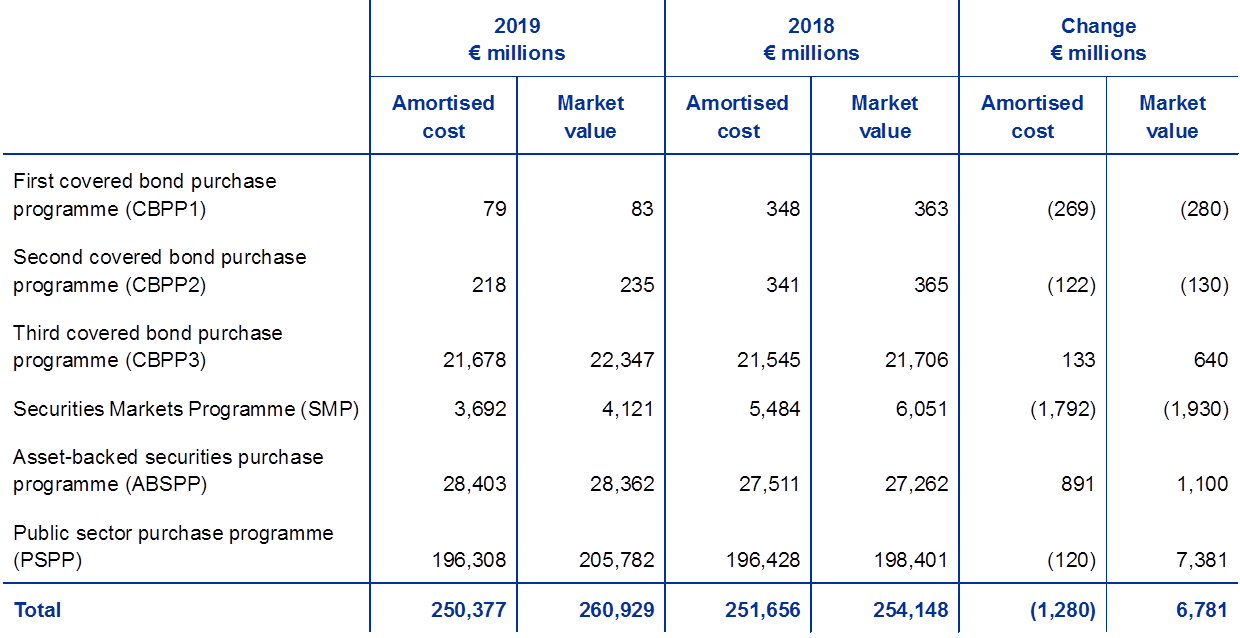
The decrease in the amortised cost value of the portfolios held under the first and second CBPPs and the SMP was due to redemptions. The decrease in the amortised cost value of securities held under the PSPP was due to the net result of the amortisation of premiums and discounts, which more than offset the net purchases conducted in the last two months of 2019.
The Governing Council assesses on a regular basis the financial risks associated with the securities held under all these programmes.
Impairment tests are conducted on an annual basis, using data as at the year-end, and are approved by the Governing Council. In these tests, impairment indicators are assessed separately for each programme. In cases where impairment indicators were observed, further analysis has been performed to confirm that the cash flows of the underlying securities have not been affected by an impairment event. Based on the results of this year’s impairment tests, no losses have been recorded by the ECB for the securities held in its monetary policy portfolios in 2019.
Note 5 - Intra-Eurosystem claims
Note 5.1 - Claims related to the allocation of euro banknotes within the Eurosystem
This item consists of the claims of the ECB vis-à-vis the euro area NCBs relating to the allocation of euro banknotes within the Eurosystem (see “Banknotes in circulation” in Section 2.3 “Accounting policies”) and as at 31 December 2019 amounted to €103,420 million (2018: €98,490 million). The remuneration of these claims is calculated daily at the latest available marginal interest rate used by the Eurosystem in its tenders for main refinancing operations[30] (see note 22.2 “Interest income arising from the allocation of euro banknotes within the Eurosystem”).
Note 6 - Other assets
Note 6.1 - Tangible and intangible fixed assets
These assets comprised the following items on 31 December 2019:

As at 1 January 2019 the ECB recognised under right-of-use buildings mainly leased office buildings and under right-of-use equipment the related building operating facilities, as well as office and other equipment.
In respect of the ECB’s main building and right-of-use office buildings, an impairment test was conducted at the end of the year and no impairment loss has been recorded.
Note 6.2 - Other financial assets
This item consists mainly of the investment of the ECB’s own funds held as a counterpart to the capital and reserves and the provision for financial risks. It also includes 3,211 shares in the Bank for International Settlements (BIS) at the acquisition cost of €42 million.
The components of this item are as follows:

The net increase in this item in 2019 was mainly due to the reinvestment of interest income generated on the ECB’s own funds portfolio and the increase in the market value of the securities held in this portfolio.
Note 6.3 - Off-balance-sheet instruments revaluation differences
This item is composed of valuation changes in swap and forward transactions in foreign currency that were outstanding on 31 December 2019 (see note 19 “Foreign exchange swap and forward transactions”). These valuation changes amounted to €619 million (2018: €578 million) and are the result of the conversion of such transactions into their euro equivalents at the exchange rates prevailing on the balance sheet date, compared with the euro values resulting from the conversion of the transactions at the average cost of the respective foreign currency on that date (see “Off-balance-sheet instruments” and “Gold and foreign currency assets and liabilities” in Section 2.3 “Accounting policies”).
Note 6.4 - Accruals and prepaid expenses
On 31 December 2019 this item stood at €2,572 million (2018: €2,738 million). It comprised mainly accrued coupon interest on securities, including outstanding interest paid at acquisition, amounting to €2,431 million (2018: €2,589 million) (see note 2.2 “Balances with banks and security investments, external loans and other external assets; and claims on euro area residents denominated in foreign currency”, note 4 “Securities of euro area residents denominated in euro” and note 6.2 “Other financial assets”).
Moreover, this item includes (a) accrued income from common Eurosystem projects (see note 27 “Other income”); (b) miscellaneous prepayments; and (c) accrued interest income on other financial assets and liabilities.
Note 6.5 - Sundry
On 31 December 2019 this item amounted to €2,221 million (2018: €2,039 million) and mainly included the accrued amount of the ECB’s interim profit distribution of €1,431 million (2018: €1,191 million) (see “Interim profit distribution” in Section 2.3 “Accounting policies” and note 11.2 “Other liabilities within the Eurosystem (net)”).
It also included balances with a value of €757 million (2018: €567 million) related to swap and forward transactions in foreign currency outstanding on 31 December 2019 that arose from the conversion of such transactions into their euro equivalents at the respective currency’s average cost on the balance sheet date, compared with the euro values at which the transactions were initially recorded (see “Off-balance-sheet instruments” in Section 2.3 “Accounting policies”).
As at 31 December 2018 this item also included an amount of €244 million which corresponded to the annual supervisory fees receivable from the supervised entities, as the ECB invoiced these fees to the supervised entities in December 2018 with a payment date in January 2019. The supervisory fees for the current year were invoiced in October 2019 with a due date in December 2019, and as a result the majority was collected within the same financial year.
Note 7 - Banknotes in circulation
This item consists of the ECB’s share (8%) of total euro banknotes in circulation (see “Banknotes in circulation” in Section 2.3 “Accounting policies”) and as at 31 December 2019 amounted to €103,420 million (2018: €98,490 million).
Note 8 - Other liabilities to euro area credit institutions denominated in euro
The Eurosystem central banks have the possibility of accepting cash as collateral in their PSPP securities lending facilities without having to reinvest it. In the case of the ECB, these operations are conducted via a specialised institution.
As at 31 December 2019 the outstanding value of such PSPP securities lending transactions conducted with euro area credit institutions was €1,325 million (2018: €1,399 million). Cash received as collateral was transferred to TARGET2 accounts. As the cash remained uninvested at the year-end, these transactions were recorded on the Balance Sheet (see “Reverse transactions” in Section 2.3 “Accounting policies”).[31]
Note 9 - Liabilities to other euro area residents denominated in euro
Note 9.1 - Other liabilities
As at 31 December 2019 this position amounted to €20,466 million (2018: €9,152 million). This item includes deposits of the European Financial Stability Facility (EFSF) and the European Stability Mechanism (ESM). In accordance with Article 21 of the Statute of the ESCB, the ECB may act as fiscal agent for Union institutions, bodies, offices or agencies, central governments, regional, local or other public authorities, other bodies governed by public law, or public undertakings of Member States.
This item also includes deposits or payments of funds accepted by the ECB and made by or on behalf of the participants in EURO1 and RT1[32] which are used as a guarantee fund for EURO1 or to support settlement in RT1.
Note 10 - Liabilities to non-euro area residents denominated in euro
As at 31 December 2019 this position amounted to €7,245 million (2018: €10,361 million). The largest component was an amount of €3,350 million (2018: €3,682 million) arising from the standing reciprocal currency arrangement with the Federal Reserve Bank of New York. Under this arrangement, US dollars are provided by the Federal Reserve System to the ECB by means of swap transactions, with the aim of offering short-term US dollar funding to Eurosystem counterparties. The ECB simultaneously enters into back-to-back swap transactions with euro area NCBs, which use the resulting funds to conduct US dollar liquidity-providing operations with Eurosystem counterparties in the form of reverse transactions. The back-to-back swap transactions result in intra-Eurosystem balances between the ECB and the NCBs (see note 11.2 “Other liabilities within the Eurosystem (net)”). Furthermore, the swap transactions conducted with the Federal Reserve System and the euro area NCBs result in forward claims and liabilities that are recorded in off-balance-sheet accounts (see note 19 “Foreign exchange swap and forward transactions”).
This item also includes an amount of €3,271 million (2018: €4,619 million) consisting of balances held with the ECB by non-euro area central banks that arise from, or are the counterpart of, transactions processed via the TARGET2 system. The decrease in these balances in 2019 was due to payments from non-euro area residents to euro area residents.
The remainder of this item consists of an amount of €625 million (2018: €2,059 million) arising from outstanding PSPP securities lending transactions conducted with non-euro area residents in which cash was received as collateral and transferred to TARGET2 accounts (see note 8 “Other liabilities to euro area credit institutions denominated in euro”).
Note 11 - Intra-Eurosystem liabilities
Note 11.1 - Liabilities equivalent to the transfer of foreign reserves
These represent the liabilities to euro area NCBs that arose from the transfer of foreign reserve assets to the ECB when they joined the Eurosystem. Pursuant to Article 30.2 of the Statute of the ESCB, these contributions are fixed in proportion to NCBs’ share in the subscribed capital of the ECB. Following the five-yearly adjustment of the NCBs’ weightings in the key for subscription to the ECB’s capital on 1 January 2019, the weighting of the euro area NCBs in the ECB’s subscribed capital decreased (see note 15 “Capital and reserves”). This resulted in a reduction in these liabilities by €448 million to €40,344 million, as shown in the table below.

The remuneration of these liabilities is calculated daily at the latest available marginal interest rate used by the Eurosystem in its tenders for main refinancing operations, adjusted to reflect a zero return on the gold component (see note 22.3 “Remuneration of NCBs’ claims in respect of foreign reserves transferred”).
Note 11.2 - Other liabilities within the Eurosystem (net)
In 2019 this item consisted of the TARGET2 balances of euro area NCBs vis-à-vis the ECB and the amount due to euro area NCBs in respect of the ECB’s interim profit distribution (see “Intra-ESCB balances/intra-Eurosystem balances” and “Interim profit distribution”, respectively, in Section 2.3 “Accounting policies”).

The decrease in the net TARGET2 liability resulted mainly from (a) the increase in the deposits accepted by the ECB in its role as fiscal agent (see note 9 “Liabilities to other euro area residents denominated in euro”); (b) the interest income received from securities held for monetary policy purposes; and (c) redemptions of securities purchased under the SMP and the first two covered bonds purchase programmes, which were settled via TARGET2 accounts. The impact of these factors was partially offset by (a) the APP net purchases, which were also settled via TARGET2 accounts; (b) the payment of the ECB’s profit distribution for 2018; (c) the decrease in cash received as collateral against the lending of PSPP securities (see note 8 “Other liabilities to euro area credit institutions denominated in euro” and note 10 “Liabilities to non-euro area residents denominated in euro”); and (d) the settlement in TARGET2 of payments from euro area residents to non-euro area residents (see note 10 “Liabilities to non-euro area residents denominated in euro”).
The remuneration of TARGET2 positions, with the exception of balances arising from back-to-back swap transactions in connection with US dollar liquidity-providing operations, is calculated daily at the latest available marginal interest rate used by the Eurosystem in its tenders for main refinancing operations.
Note 12 - Other liabilities
Note 12.1 - Off-balance-sheet instruments revaluation differences
This item is composed of valuation changes in swap and forward transactions in foreign currency that were outstanding on 31 December 2019 (see note 19 “Foreign exchange swap and forward transactions”). These valuation changes amounted to €709 million (2018: €641 million) and are the result of the conversion of such transactions into their euro equivalents at the exchange rates prevailing on the balance sheet date, compared with the euro values resulting from the conversion of the transactions at the average cost of the respective foreign currency on that date (see “Off-balance-sheet instruments” and “Gold and foreign currency assets and liabilities” in Section 2.3 “Accounting policies”).
Note 12.2 - Accruals and income collected in advance
This item comprised the following components on 31 December 2019:

Note 12.3 - Sundry
On 31 December 2019 this item stood at €2,188 million (2018: €1,178 million). It included balances amounting to €662 million (2018: €580 million) related to swap and forward transactions in foreign currency that were outstanding on 31 December 2019 (see note 19 “Foreign exchange swap and forward transactions”). These balances arose from the conversion of such transactions into their euro equivalents at the respective currency’s average cost on the balance sheet date, compared with the euro values at which the transactions were initially recorded (see “Off-balance-sheet instruments” in Section 2.3 “Accounting policies”).
The item also included a lease liability of €232 million, resulting from the implementation of the new accounting policy for leases from 1 January 2019 (see “Leases” and “Changes to accounting policies” in Section 2.3 “Accounting policies”).
In addition, this item includes the ECB’s net defined benefit liability in respect of the post-employment and other long-term benefits of its staff and the members of the Executive Board, as well as the members of the Supervisory Board employed by the ECB. The termination benefits of ECB staff are also included.
The ECB’s post-employment benefits, other long-term benefits and termination benefits
Balance Sheet
The amounts recognised in the Balance Sheet under the item “Sundry” (liabilities) in respect of post-employment, other long-term and staff termination benefits were as follows:

Note: The columns labelled “Boards” report amounts in respect of both the Executive Board and the Supervisory Board.
In 2019 the present value of the defined benefit obligation vis-à-vis staff of €2,497 million (2018: €1,608 million) included unfunded benefits amounting to €323 million (2018: €226 million) relating to post-employment benefits other than pensions, to other long-term benefits and to staff termination benefits. The present value of the defined benefit obligation vis-à-vis the members of the Executive Board and the members of the Supervisory Board of €39 million (2018: €29 million) relates solely to unfunded arrangements in place for post-employment and other long-term benefits.
Remeasurements of the ECB’s net defined benefit liability in respect of post-employment benefits are recognised in the Balance Sheet under liability item “Revaluation accounts”. In 2019, remeasurement losses under that liability item amounted to €749 million (2018: €129 million) (see note 14 “Revaluation accounts”).
Changes in the defined benefit obligation, plan assets and remeasurement results
Changes in the present value of the defined benefit obligation were as follows:

Note: The columns labelled “Boards” report amounts in respect of both the Executive Board and the Supervisory Board.
1) Net figure including compulsory contributions and transfers into/out of the plans. The compulsory contributions paid by staff are 7.4%, whilst those paid by the ECB are 20.7% of the basic salary.
The total remeasurement losses of €763 million on the defined benefit obligation in 2019 arose primarily as a result of the decrease in the discount rate from 2.3% in 2018 to 1.2% in 2019. Additional sources of remeasurement losses included the application of new mortality tables and, to a much lesser extent, experience adjustments reflecting the difference between the actuarial assumptions made in the previous year’s report and actual experience.
Benefits paid decreased to €24 million in 2019 (2018: €46 million), mainly owing to lower one-off termination payments to staff members accepted for the temporary Career Transition Support (CTS) scheme. This scheme was introduced in 2017 for long-serving staff members to facilitate their voluntary transition to a career outside the ECB under specified conditions.
Changes in 2019 in the fair value of plan assets in the defined benefit pillar relating to staff were as follows:
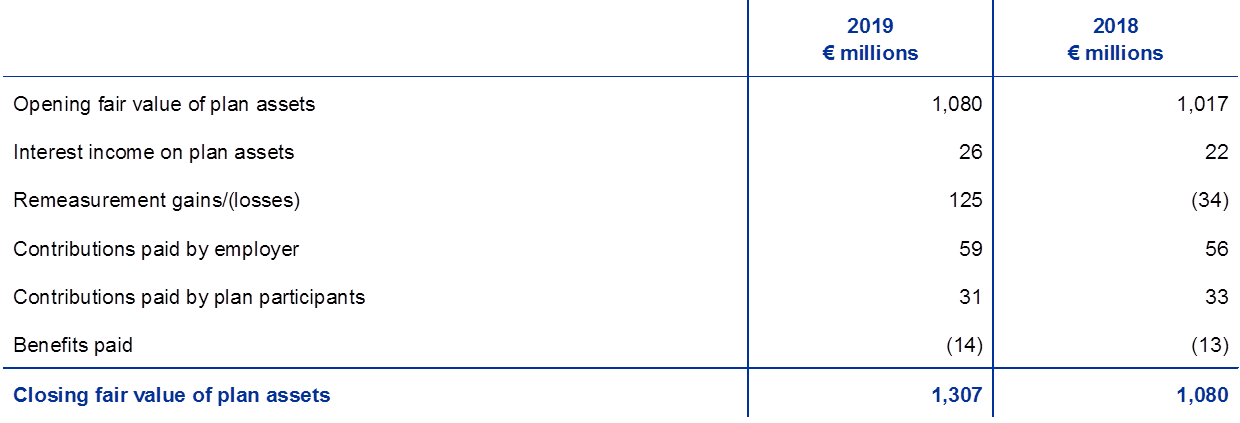
The remeasurement gain on plan assets in 2019 reflected the fact that the actual return on the fund units was materially higher than the assumed interest income on plan assets.
Changes in 2019 in the remeasurement results were as follows:

Profit and Loss Account
The amounts recognised in the Profit and Loss Account in 2019 were as follows:

Note: The columns labelled “Boards” report amounts in respect of both the Executive Board and the Supervisory Board.
The total remeasurement losses on other long-term and termination benefits recognised directly in the Profit and Loss Account amounted to €18 million in 2019. The majority of this amount related to other long-term benefits and arose primarily as a result of the decrease in the discount rate from 2.3% in 2018 to 1.2% in 2019.
The current service cost declined in 2019 to €92 million (2018: €98 million), mainly owing to an increase in the discount rate from 2.1% in 2017 to 2.3% in 2018.[33]
Key assumptions
In preparing the valuations referred to in this note, the independent actuaries have used assumptions which the Executive Board has accepted for the purposes of accounting and disclosure. The principal assumptions used for the purposes of calculating the liability for post-employment benefits and other long-term benefits are as follows:

1) These assumptions were used for calculating the part of the ECB’s defined benefit obligation which is funded by assets with an underlying capital guarantee.
2) In addition, allowance is made for prospective individual salary increases of up to 1.8% per annum, depending on the age of the plan participants.
3) In accordance with the ECB’s pension plan rules, pensions will be increased annually. If general salary adjustments for ECB employees are below price inflation, any increase in pensions will be in line with the general salary adjustments. If the general salary adjustments exceed price inflation, they will be applied to determine the increase in pensions, provided that the financial position of the ECB’s pension plans permits such an increase.
Furthermore, voluntary contributions made by staff in a defined contribution pillar in 2019 amounted to €171 million (2018: €140 million). These contributions are invested in the plan assets and give rise to a corresponding obligation of equal value.
Note 13 - Provisions
This item consists mainly of a provision for financial risks. In 2019 its scope was extended to cover all financial risks (i.e. market, liquidity and credit risks). It previously covered foreign exchange rate, interest rate, credit and gold price risks only.
The provision for financial risks will be used to the extent deemed necessary by the Governing Council to offset future realised and unrealised losses. The size of and continuing requirement for this provision is reviewed annually, based on the ECB’s assessment of its exposure to these risks and taking a range of factors into account. Its size, together with any amount held in the general reserve fund, may not exceed the value of the ECB’s capital paid up by the euro area NCBs.
Taking into account (i) the reduction in the weighting of the euro area NCBs in the subscribed capital of the ECB as a result of the five-yearly adjustment of the key for subscription to the ECB’s capital as at 1 January 2019 (see note 15 “Capital and reserves”) and (ii) the results of the assessment of the ECB’s exposures to financial risks, the Governing Council decided to release €84 million from the ECB’s provision for financial risks on 31 December 2019 in order to comply with the maximum allowed ceiling. Thus the provision for financial risks as at 31 December 2019 amounted to €7,536 million, which corresponds to the value of the ECB’s capital paid up by the euro area NCBs as at that date.
Note 14 - Revaluation accounts
This item consists mainly of revaluation balances arising from unrealised gains on assets, liabilities and off-balance-sheet instruments (see “Income recognition”, “Gold and foreign currency assets and liabilities”, “Securities” and “Off-balance-sheet instruments” in Section 2.3 “Accounting policies”). It also includes remeasurements of the ECB’s net defined benefit liability in respect of post-employment benefits (see “The ECB’s post-employment benefits, other long-term benefits and termination benefits” in Section 2.3 “Accounting policies” and note 12.3 “Sundry”).

The increase in the size of the revaluation accounts is predominately due to the rise in the price of gold and the depreciation of the euro against the US dollar and Japanese yen in 2019.
The foreign exchange rates used for the year-end revaluation were as follows:

Note 15 - Capital and reserves
Note 15.1 - Capital
Change to the ECB’s capital key
Pursuant to Article 29 of the Statute of the ESCB, the weightings assigned to the NCBs in the key for subscription to the ECB’s capital are adjusted every five years[34] according to the shares of the respective Member States in the total population and gross domestic product of the EU, in equal measure.[35] The fourth such adjustment following the establishment of the ECB was made on 1 January 2019, and the NCBs’ capital key shares were adjusted as follows:
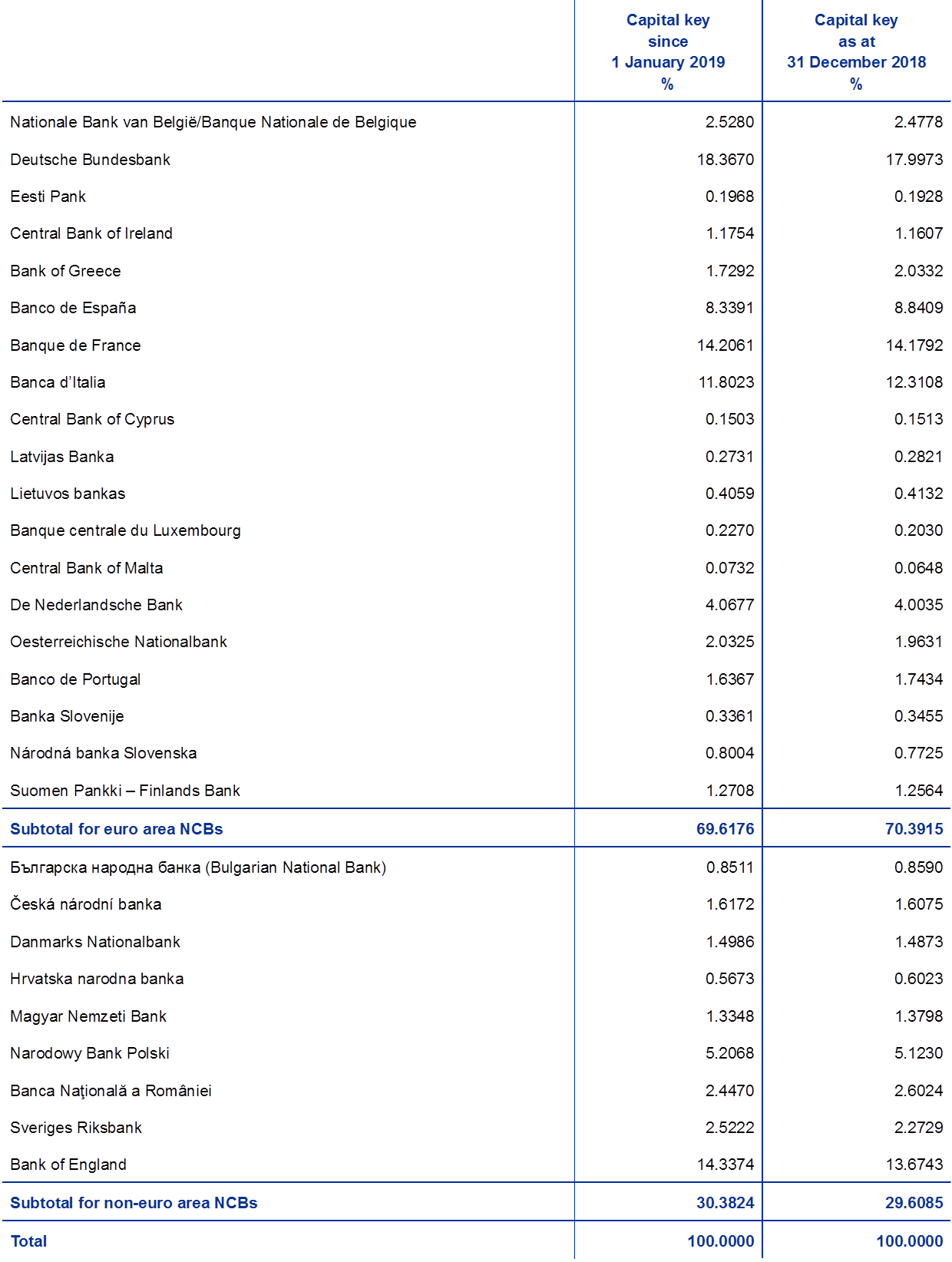
Paid-up capital of the ECB
The subscribed capital of the ECB is €10,825 million. Following the five-yearly adjustment of the ECB’s capital key, the weighting of the euro area NCBs (with fully paid-up subscriptions) in the ECB’s subscribed capital was reduced by 0.7739 percentage points, while that of the non-euro area NCBs (which only pay up 3.75% of their subscriptions) increased by the same amount. As a result, the ECB’s paid-up capital decreased by €81 million to €7,659 million on 1 January 2019, as shown in the table below:

2.5 Off-balance-sheet instruments
Note 16 - Securities lending programmes
As part of the management of the ECB’s own funds, the ECB has a securities lending programme agreement in place under which a specialised institution enters into securities lending transactions on behalf of the ECB.
In addition, in accordance with the Governing Council’s decisions, the ECB has made available for lending its holdings of securities purchased under the first, second and third CBPPs, as well as its holdings of securities purchased under the PSPP and those purchased under the SMP that are also eligible for purchase under the PSPP.[36]
Unless these securities lending operations are conducted against cash collateral that remains uninvested at the end of the year, they are recorded in off-balance-sheet accounts.[37] Such securities lending operations with a value of €10,076 million (2018: €9,646 million) were outstanding as at 31 December 2019. Of this amount, €5,502 million (2018: €4,440 million) related to the lending of securities held for monetary policy purposes.
Note 17 - Interest rate futures
As at 31 December 2019 the following foreign currency transactions, presented at year-end market rates, were outstanding:

These transactions were conducted in the context of the management of the ECB’s foreign reserves.
Note 18 - Interest rate swaps
Interest rate swap transactions with a notional value of €703 million (2018: €519 million), presented at year-end market rates, were outstanding as at 31 December 2019. These transactions were conducted in the context of the management of the ECB’s foreign reserves.
Note 19 - Foreign exchange swap and forward transactions
Management of foreign reserves
Foreign exchange swap and forward transactions were conducted in 2019 in the context of the management of the ECB’s foreign reserves. Claims and liabilities resulting from these transactions that were outstanding as at 31 December 2019 are presented at year-end market rates as follows:

Liquidity-providing operations
US dollar-denominated claims and liabilities with a settlement date in 2019 arose in connection with the provision of US dollar liquidity to Eurosystem counterparties (see note 10 “Liabilities to non-euro area residents denominated in euro”).
Note 20 - Administration of borrowing and lending operations
In 2019 the ECB continued to be responsible for the administration of the borrowing and lending operations of the EU under the medium-term financial assistance facility and the European Financial Stabilisation Mechanism, for the loan facility agreement for Greece, and for the administration of payments relating to two EFSF loans. In 2019 the ECB processed payments related to these operations, as well as payments linked to member subscriptions to the ESM’s authorised capital stock.
Note 21 - Contingent liabilities from pending lawsuits
Several lawsuits have been filed against the ECB and other EU institutions by a number of depositors, shareholders and bondholders of Cypriot credit institutions. The applicants allege that they have suffered financial losses as a result of acts that they deem to have led to the restructuring of these credit institutions in the context of the financial assistance programme for Cyprus. Two of these cases were dismissed on substance by the General Court of the EU in 2018, and an appeal against these judgments is currently pending before the Court of Justice of the EU. This follows orders of the General Court in 2014 which found twelve similar cases inadmissible in their entirety and, following appeals, judgments of the Court of Justice in 2016 which either confirmed the inadmissibility or ruled in favour of the ECB. The ECB’s involvement in the process leading up to the conclusion of the financial assistance programme was limited to the provision of technical advice, pursuant to the ESM Treaty, acting in liaison with the European Commission, as well as the issuance of a non-binding opinion on the Cypriot draft resolution law. It is therefore considered that no losses will be incurred by the ECB as a result of these cases.
2.6 Notes on the Profit and Loss Account
Note 22 - Net interest income
Note 22.1 - Interest income on foreign reserve assets
This item includes interest income, net of interest expense, in respect of the ECB’s net foreign reserve assets, as follows:
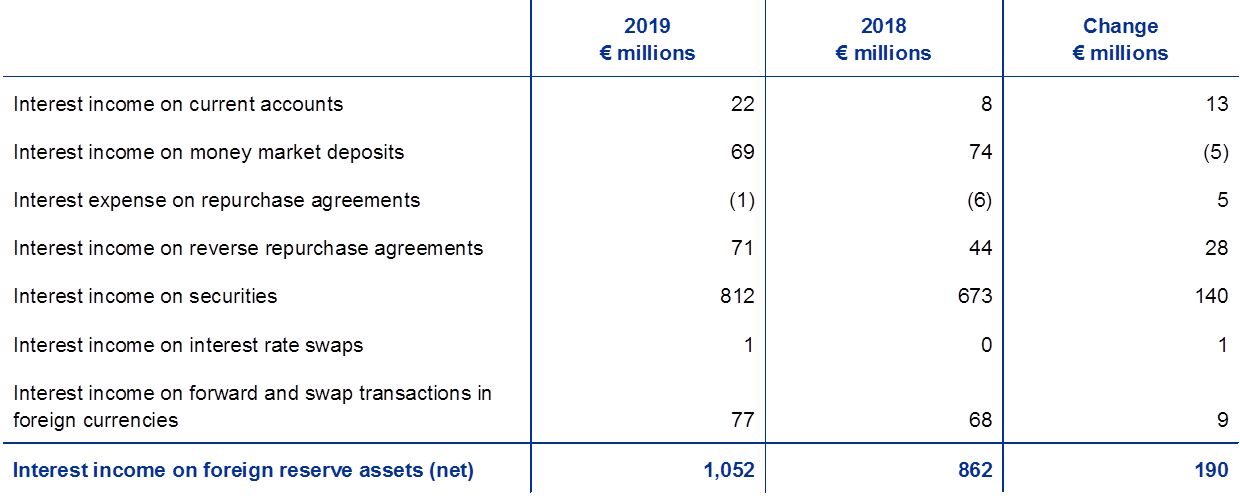
The overall increase in net interest income in 2019 was mainly due to higher interest income generated on the US dollar portfolio. The appreciation of the US dollar against the euro also contributed to this increase.
Note 22.2 - Interest income arising from the allocation of euro banknotes within the Eurosystem
This item consists of the interest income relating to the ECB’s 8% share of the total euro banknote issue (see “Banknotes in circulation” in Section 2.3 “Accounting policies” and note 5.1 “Claims related to the allocation of euro banknotes within the Eurosystem”). For 2019 this interest income was zero, owing to the fact that the rate on the main refinancing operations remained at 0% during the entire year.
Note 22.3 - Remuneration of NCBs’ claims in respect of foreign reserves transferred
Remuneration paid to euro area NCBs on their claims in respect of the foreign reserve assets transferred to the ECB (see note 11.1 “Liabilities equivalent to the transfer of foreign reserves”) is disclosed under this heading. The remuneration in 2019 was zero, reflecting the fact that the rate on the main refinancing operations was 0% during the entire year.
Note 22.4 - Other interest income; and other interest expense
Other interest income and other interest expense in 2019 were as follows:
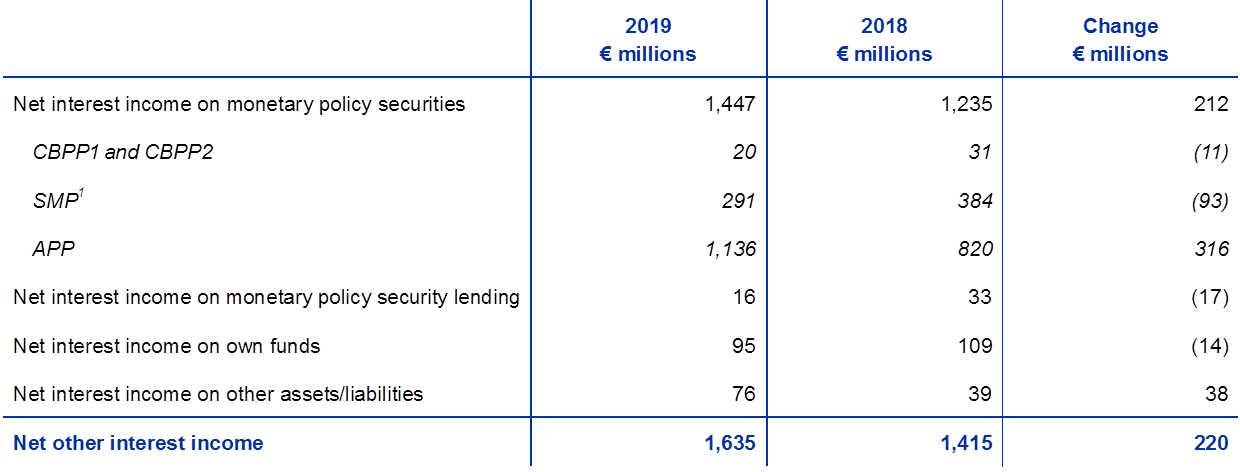
1) The ECB’s net interest income on SMP holdings of Greek government bonds amounted to €94 million (2018: €127 million).
Note 23 - Realised gains/losses arising from financial operations
Net realised gains/losses arising from financial operations in 2019 were as follows:

Net realised price gains/losses include realised gains and losses on securities, interest rate futures and interest rate swaps. The net realised price gains in 2019 were mainly due to realised price gains generated in the US dollar portfolio as a result of the lower US dollar securities yields compared to 2018.
Note 24 - Write-downs on financial assets and positions
Write-downs on financial assets and positions in 2019 were as follows:

The market value of a number of securities held in the own funds and US dollar portfolios declined, alongside an increase in the corresponding yields towards the end of 2019. This resulted in unrealised price losses at the year-end.
Note 25 - Net income/expense from fees and commissions

In 2019 income under this heading consisted mainly of supervisory fees and administrative penalties imposed on supervised entities for non-compliance with the EU banking regulations on prudential requirements (including ECB supervisory decisions). Expenses consisted mainly of custody fees.
Income and expenses related to supervisory tasks
The ECB levies annual fees on supervised entities in order to recover expenditure incurred in the performance of its supervisory tasks. The ECB announced in April 2019 that the annual supervisory fees in 2019 would amount to €576 million. This figure was based on estimated annual expenses for supervisory tasks of €559 million in 2019, adjusted for (i) the deficit of €15 million carried forward from the 2018 fee period and (ii) amounts reimbursed to individual banks for previous fee periods[38] (€2 million).
Based on the actual expenses incurred by the ECB in the performance of its banking supervisory tasks, the supervisory fee income for 2019 stood at €537 million. The resulting surplus of €22 million arising from the difference between the estimated expenses (€559 million) and the actual expenses (€537 million) for 2019 is shown under the heading “Accruals and income collected in advance” (see note 12.2 “Accruals and income collected in advance”). It will reduce the total amount to be levied for the fee period 2020, which, following the implementation of ex post invoicing under the revised fee framework,[39] will take place in 2021.
The ECB is also entitled to impose administrative penalties on supervised entities for failure to comply with the EU banking regulations on prudential requirements (including ECB supervisory decisions). The related income is not considered in the calculation of the annual supervisory fees. Instead, it is recorded as income in the ECB’s Profit and Loss Account and is distributed to euro area NCBs as part of the ECB’s profit distribution regime. In 2019 the income arising from penalties on supervised entities amounted to €7 million.
Thus, the related income of the ECB for supervisory tasks in 2019 was as follows:

Banking supervision-related expenses result from the direct supervision of significant entities, the oversight of the supervision of less significant entities and the performance of horizontal tasks and specialised services. They also include expenses arising from support areas needed to fulfil the ECB’s supervisory responsibilities, including premises, human resources management, administrative services, budgeting and controlling, accounting, legal, communication and translation services, internal audit, and statistical and information technology services.
For 2019 the total actual expenses related to the ECB’s supervisory tasks, which are recovered via the annual supervisory fees, were as follows:

The increase in the average number of staff working for ECB Banking Supervision led to a corresponding increase in salaries and benefits. The higher staff numbers also drove the increase in premises-related costs, while the decrease in other operating expenditure was mainly due to lower consultancy expenses in relation to supervisory tasks, most notably the Targeted Review of Internal Models (TRIM), which will conclude in 2020.
Note 26 - Income from equity shares and participating interests
Dividends received on shares which the ECB holds in the BIS (see note 6.2 “Other financial assets”) are shown under this heading.
Note 27 - Other income
Other miscellaneous income during 2019 arose mainly from contributions of euro area NCBs to costs incurred by the ECB in connection with joint Eurosystem projects.
Note 28 - Staff costs
Staff costs in 2019 were as follows:

1) Salaries and allowances are, in essence, modelled on, and comparable with, the remuneration scheme of the European Union.
The average number of employees, expressed in full-time equivalents (FTEs)[40], amounted to 3,770 (2018: 3,546), of which 349 were managerial staff (2018: 337).
Staff costs increased in 2019 mainly owing to the higher average number of staff employed by the ECB and higher costs in relation to other long-term benefits, mainly as a result of the use of a lower discount rate for the actuarial valuation at the end of 2019 (see note 12.3 “Sundry”).
Remuneration of the Executive and Supervisory Boards
Members of the Executive Board and the members of the Supervisory Board employed by the ECB receive a basic salary and allowances for residence and representation. In the case of the President, a residence is provided in lieu of a residence allowance. Subject to the Conditions of Employment for Staff of the European Central Bank, members of both boards may be entitled to household, child and education allowances, depending on their individual circumstances. Salaries are subject to a tax for the benefit of the EU, as well as to deductions in respect of contributions to the pension, medical, long-term care and accident insurance schemes. Allowances are non-taxable and non-pensionable.
In 2019 the basic salaries of the members of the Executive Board and members of the Supervisory Board employed by the ECB (i.e. excluding representatives of national supervisors) were as follows:[41]

1) This total excludes the salary of the Vice-Chair of the Supervisory Board (Sabine Lautenschläger until February 2019 and Yves Mersch since October 2019), which is reported with those of the other members of the Executive Board.
Total allowances paid to members of both boards and the ECB’s contributions to medical, long-term care and accident insurance schemes on their behalf amounted to €1,182,767 (2018: €835,371). Transitional payments may be made to former members of both boards for a limited period after the end of their terms of office. In 2019 these payments, the related family allowances and the ECB’s contributions to the medical, long-term care and accident insurance schemes of former members of both boards amounted to €864,287 (2018: €169,346). The increase in total allowances and transitional payments is mainly due to a higher number of board members leaving/joining the ECB in 2019 than in the previous year.
Pension payments, including post-employment allowances, and contributions to the medical, long-term care and accident insurance schemes for former board members and their dependants amounted to €1,848,157 (2018: €3,047,064).[42] In 2019 this amount included a transfer out to another pension scheme on the retirement of a former board member. In 2018 it included a lump sum payment on retirement to a former board member in lieu of future pension payments.
Note 29 - Administrative expenses
This item, amounting to €476 million (2018: €525 million), covers all other current expenses relating to consultancy, information technology, maintenance of premises, goods and equipment of a non-capital nature, and other services and supplies together with staff-related expenses, including training, recruitment, relocation and accommodation expenses.
The decrease in 2019 was mainly due to lower expenses in relation to rent of space, agency staff and external consultancy support. Lower rental expenses resulted from the on-balance-sheet recognition of the right-of-use buildings (see “Changes to accounting policies” in Section 2.3 “Accounting policies” and note 6.1 “Tangible and intangible fixed assets”) and the recording of the related expenses as depreciation.
Note 30 - Banknote production services
This expense arises predominantly from the cross-border transportation of euro banknotes between banknote printing works and NCBs, for the delivery of new banknotes, and between NCBs, for the compensation of shortages with surplus stocks. These costs are borne centrally by the ECB.
2.7 Post-balance sheet events
Note 31 - Adjustment of the ECB’s capital key following the departure of the United Kingdom from the EU
As a result of the departure of the United Kingdom from the EU and the consequent withdrawal of the Bank of England from the ESCB, the weightings assigned to the remaining NCBs in the key for subscription to the ECB’s capital were adjusted with effect from 1 February 2020 as follows:
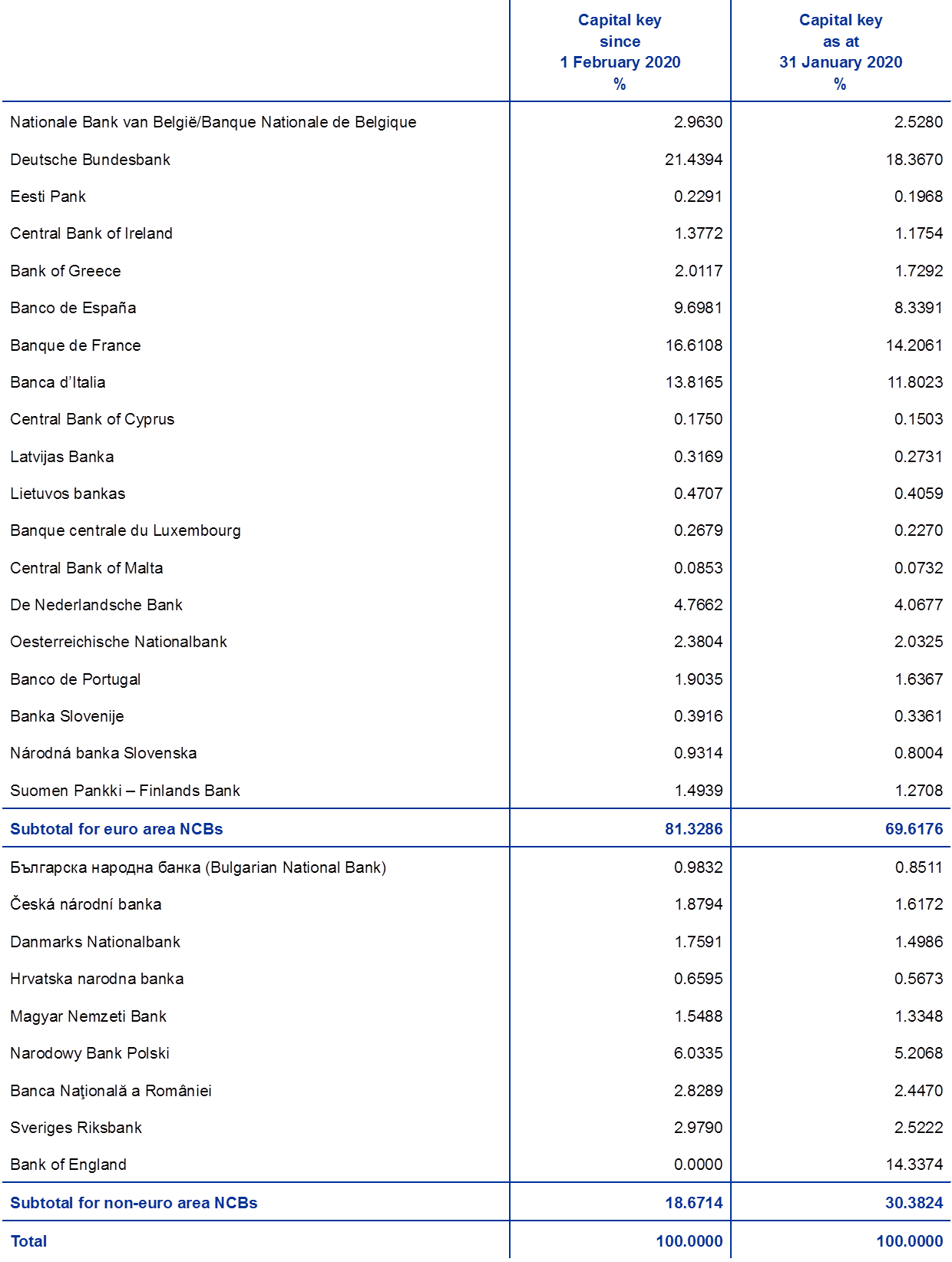
Impact on the ECB’s capital
The ECB kept its subscribed capital unchanged at €10,825 million after the Bank of England’s withdrawal from the ESCB. The share of the Bank of England in the ECB’s subscribed capital, which stood at 14.3%, was reallocated among both euro area and remaining non-euro area NCBs.
The ECB’s paid-up capital will remain unchanged at €7,659 million in 2020, as the remaining NCBs covered the Bank of England’s former paid-up capital of €58 million. Over the next two years euro area NCBs will pay up, in two annual instalments, the remainder of their increased subscriptions to the ECB’s capital following the Bank of England’s withdrawal from the ESCB. This will lead to an increase in the ECB’s paid-up capital from €7,659 million in 2020 to €8,270 million in 2021 and €8,880 million in 2022.
Impact on NCBs’ claims equivalent to the foreign reserve assets transferred to the ECB
Pursuant to Article 30.2 of the Statute of the ESCB, the contributions of the NCBs to the transfer of foreign reserve assets to the ECB are fixed in proportion to their share in the ECB’s subscribed capital. Following (a) the increase in the weighting of the euro area NCBs (which have transferred foreign reserve assets to the ECB) in the ECB’s subscribed capital resulting from Bank of England’s withdrawal from the ESCB and (b) the decision of the Governing Council to reduce the proportion of the euro area NCBs’ contributions, so that the total amount of foreign reserve assets transferred by the euro area NCBs remains at the same level as before the Bank of England’s withdrawal from the ESCB, the NCBs’ total claim equivalent to these transfers remains virtually unchanged.
3 Independent auditor’s report
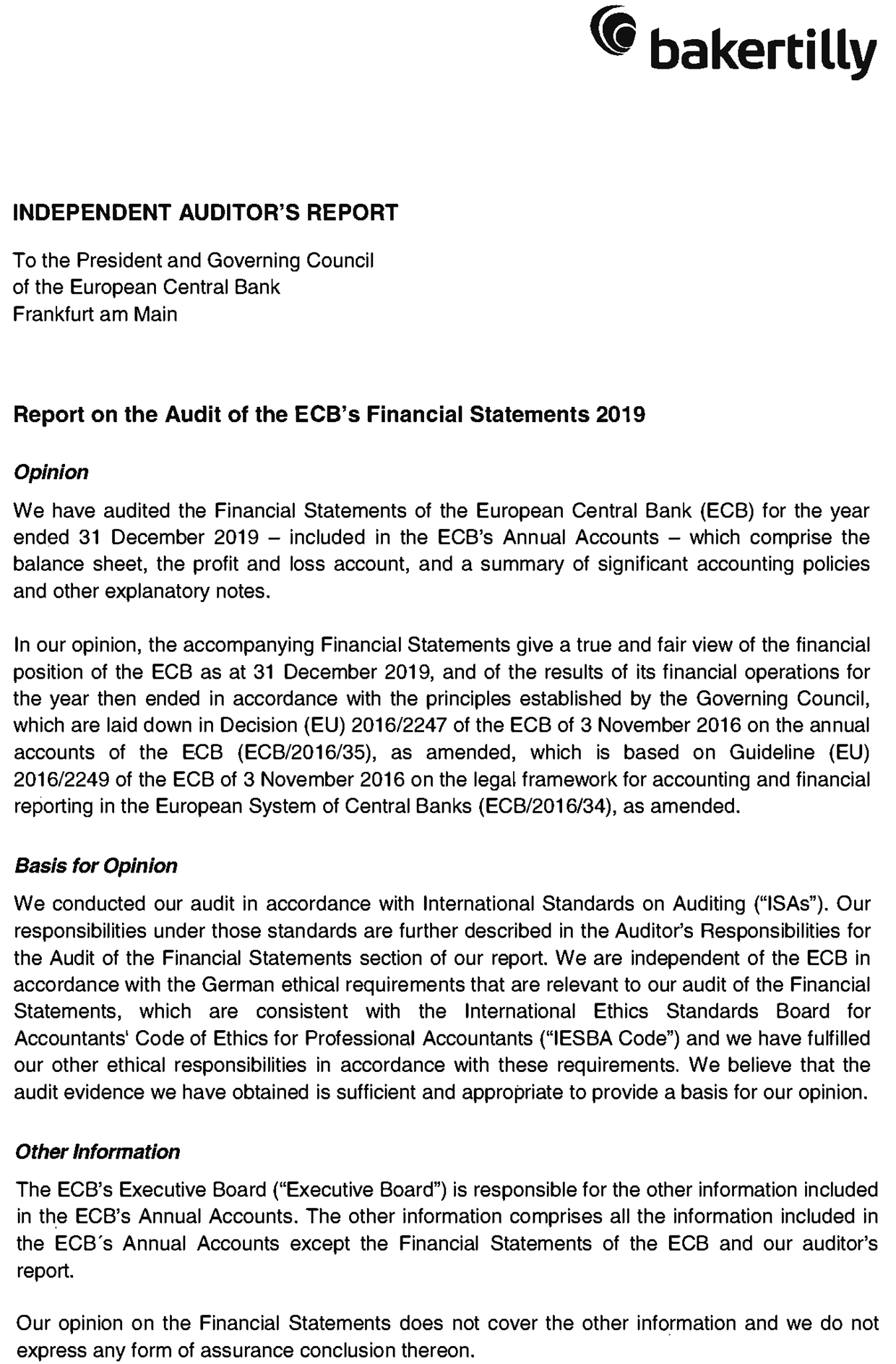


4 Note on profit distribution/allocation of losses
This note is not part of the financial statements of the ECB for the year 2019.
Pursuant to Article 33 of the Statute of the ESCB, the net profit of the ECB shall be transferred in the following order:
- an amount to be determined by the Governing Council, which may not exceed 20% of the net profit, shall be transferred to the general reserve fund, subject to a limit equal to 100% of the capital; and
- the remaining net profit shall be distributed to the shareholders of the ECB in proportion to their paid-up shares.[43]
In the event of a loss incurred by the ECB, the shortfall may be offset against the general reserve fund of the ECB and, if necessary, following a decision by the Governing Council, against the monetary income of the relevant financial year in proportion and up to the amounts allocated to the NCBs in accordance with Article 32.5 of the Statute of the ESCB.[44]
The ECB’s net profit for 2019 was €2,366 million. Following a decision by the Governing Council, an interim profit distribution, amounting to €1,431 million, was paid out to the euro area NCBs on 31 January 2020. Furthermore, the Governing Council decided to distribute the remaining profit of €935 million to the euro area NCBs.

© European Central Bank, 2021
Postal address 60640 Frankfurt am Main, Germany
Telephone +49 69 1344 0
Website www.ecb.europa.eu
All rights reserved. Reproduction for educational and non-commercial purposes is permitted provided that the source is acknowledged.
For specific terminology please refer to the ECB glossary (available in English only).
PDF ISBN 978-92-899-4114-3, ISSN 2443-4760, doi:, QB-BS-20-001-EN-N
HTML ISBN 978-92-899-4131-0, ISSN 2443-4760, doi:10.2866/817990, QB-BS-20-001-EN-Q
- Throughout this document, the numbers presented may not add up precisely to the totals and percentages may not precisely reflect the absolute figures owing to rounding.
- The “financial statements” comprise the Balance Sheet, the Profit and Loss Account and the related notes. The “Annual Accounts” comprise the financial statements, the management report, the auditor’s report and the note on profit distribution/allocation of losses.
- Protocol on the Statute of the European System of Central Banks and of the European Central Bank.
- The APP consists of the third covered bond purchase programme (CBPP3), the asset-backed securities purchase programme (ABSPP), the public sector purchase programme (PSPP) and the corporate sector purchase programme (CSPP). The ECB does not acquire securities under the CSPP. Further details on the APP can be found on the ECB’s website.
- In 2019 the total value of euro banknotes in circulation in the Eurosystem grew by 5% to €1,293 billion. The ECB holds 8% of the total value of euro banknotes in circulation. This share is recorded under the items “Banknotes in circulation” and “Intra-Eurosystem claims”.
- See the press release of 12 September 2019 on the Governing Council’s decisions.
- The amortisation emerges from the accounting principle that requires securities to be revalued upwards or downwards over time towards their maturity date depending on whether they have been purchased at prices below or above their face value. The APP holdings were bought, on average, at a premium, and, consequently, all other things being equal, the book value of the holdings is decreasing over time.
- These holdings comprise assets included under the balance sheet positions “Claims on non-euro area residents denominated in foreign currency – Balances with banks and security investments, external loans and other external assets” and “Claims on euro area residents denominated in foreign currency”.
- The expenses incurred by the ECB in the performance of its supervisory tasks are recovered via annual fees levied on supervised entities.
- The balance sheet item “Revaluation accounts” also includes remeasurements in respect of post-employment benefits.
- The ECB's income on euro banknotes in circulation comprises the interest income accruing to the ECB on the remuneration of its intra-Eurosystem claims on NCBs related to its 8% share of total euro banknotes in circulation.
- Supervisory fees are included under “Other income and expenses” (see Chart 11).
- The ES is defined as a probability-weighted average loss that occurs in the worst (1-p)% of scenarios, where p denotes the confidence level.
- Further details on the risk modelling approach can be found in “The financial risk management of the Eurosystem’s monetary policy operations”, ECB, July 2015.
- Operational risk is defined as the risk of a negative financial, business or reputational impact resulting from people, the inadequate implementation or failure of internal governance and business processes, the failure of systems on which processes rely, or external events (e.g. natural disasters or external attacks).
- Further information about the ECB’s governance structure can be found on the ECB’s website.
- The detailed accounting policies of the ECB are laid down in Decision (EU) 2016/2247 of the ECB of 3 November 2016 on the annual accounts of the ECB (ECB/2016/35) (OJ L 347, 20.12.2016, p. 1), as amended. In order to ensure the harmonised accounting and financial reporting of Eurosystem operations, the Decision is based on Guideline (EU) 2016/2249 of the ECB of 3 November 2016 on the legal framework for accounting and financial reporting in the European System of Central Banks (ECB/2016/34) (OJ L 347, 20.12.2016, p. 37), as amended. These policies, which are reviewed and updated regularly as deemed appropriate, are consistent with the provisions of Article 26.4 of the Statute of the ESCB, which require a harmonised approach to the rules governing the accounting and financial reporting of Eurosystem operations.
- A minimum threshold of €100,000 applies for administrative accruals and provisions.
- As at 31 December 2019 the non-euro area NCBs participating in TARGET2 were Българска народна банка (Bulgarian National Bank), Danmarks Nationalbank, Hrvatska narodna banka, Narodowy Bank Polski and Banca Naţională a României.
- The funds accumulated by a staff member through voluntary contributions can be used at retirement to purchase an additional pension. This pension is included in the defined benefit obligation from that point on.
- Decision of the ECB of 13 December 2010 on the issue of euro banknotes (recast) (ECB/2010/29) (2011/67/EU) (OJ L 35, 9.2.2011, p. 26), as amended.
- “Banknote allocation key” means the percentages that result from taking into account the ECB’s share in the total euro banknote issue and applying the subscribed capital key to the NCBs’ share in that total.
- Decision (EU) 2016/2248 of the ECB of 3 November 2016 on the allocation of monetary income of the national central banks of Member States whose currency is the euro (ECB/2016/36) (OJ L 347, 20.12.2016, p. 26).
- Decision (EU) 2015/298 of the ECB of 15 December 2014 on the interim distribution of the income of the ECB (recast) (ECB/2014/57) (OJ L 53, 25.2.2015, p. 24), as amended.
- This corresponds to 504.8 tonnes.
- These holdings comprise assets minus liabilities denominated in the given foreign currency that are subject to foreign currency revaluation. They are included under the headings “Claims on non-euro area residents denominated in foreign currency”, “Claims on euro area residents denominated in foreign currency”, “Accruals and prepaid expenses”, “Off-balance-sheet instruments revaluation differences” (liabilities side) and “Accruals and income collected in advance” and take into account foreign exchange forward and swap transactions included in off-balance-sheet items. Price gains on financial instruments denominated in foreign currency arising as a result of revaluations are not included.
- The ECB does not acquire securities under the corporate sector purchase programme (CSPP).
- The APP consists of the third covered bond purchase programme (CBPP3), the ABSPP, the PSPP and the CSPP. Further details on the APP can be found on the ECB’s website.
- Market values are indicative and are derived on the basis of market quotes. When market quotes are not available, market prices are estimated using internal Eurosystem models.
- Since 16 March 2016 the interest rate used by the Eurosystem in its tenders for main refinancing operations has been 0.00%.
- Securities lending transactions that do not result in uninvested cash collateral at the year-end are recorded in off-balance-sheet accounts (see note 16 “Securities lending programmes”).
- EURO1 and RT1 are payment systems operated by ABE CLEARING S.A.S à capital variable (EBA Clearing).
- The current service cost is estimated using the discount rate that applied in the previous year.
- These weights are also adjusted whenever there is a change in the composition of the NCBs that contribute to the ECB’s capital. These are the NCBs of EU Member States.
- The statistical data used for this adjustment were notified to the ECB by the European Commission in accordance with the rules laid down in Council Decision 2003/517/EC of 15 July 2003 on the statistical data to be used for the adjustment of the key for subscription to the capital of the ECB (OJ L 181, 19.7.2003, p. 43).
- The ECB does not purchase securities under the CSPP and consequently has no related holdings available for lending.
- If cash collateral remains uninvested at the year-end, these transactions are recorded in on-balance-sheet accounts (see note 8 “Other liabilities to euro area credit institutions denominated in euro” and note 10 “Liabilities to non-euro area residents denominated in euro”).
- See Article 5(3) of Regulation (EU) No 1163/2014 of the European Central Bank of 22 October 2014 on supervisory fees (ECB/2014/41) (OJ L 311, 31.10.2014, p. 23).
- As of the fee period 2020, the ECB’s supervisory fees will be calculated after the closure of the fee period in accordance with Regulation (EU) 2019/2155 of the ECB of 5 December 2019 amending Regulation (EU) No 1163/2014 on supervisory fees (ECB/2019/37) (OJ L 327, 17.12.2019, p. 70).
- A full-time equivalent (FTE) is a unit equivalent to one employee working full-time for one year. Staff with permanent, fixed or short-term contracts and participants in the ECB’s Graduate Programme are included in proportion to their hours worked. Staff on maternity or on long-term leave are also included, while staff on unpaid leave are excluded.
- Amounts are presented gross, i.e. before any tax deductions for the benefit of the EU.
- For the net amount charged to the Profit and Loss Account in relation to the pension arrangements for current members of the Executive Board and current members of the Supervisory Board employed by the ECB, see note 12.3 “Sundry”.
- Non-euro area NCBs are not entitled to receive any share of the ECB’s distributable profits, nor are they liable to cover any loss of the ECB.
- Under Article 32.5 of the Statute of the ESCB, the sum of the NCBs’ monetary income shall be allocated to the NCBs in proportion to their paid-up shares in the capital of the ECB.


